#Humanoid Robot Size
Explore tagged Tumblr posts
Text
Humanoid Robot Research – Growth Opportunities and Revenue Statistics by Forecast

Humanoid Robot Market Information
The Humanoid Robot Market Report provides essential insights for business strategists, offering a comprehensive overview of industry trends and growth projections. It includes detailed historical and future data on costs, revenues, supply, and demand, where applicable. The report features an in-depth analysis of the value chain and distributor networks.
Employing various analytical techniques such as SWOT analysis, Porter’s Five Forces analysis, and feasibility studies, the report offers a thorough understanding of competitive dynamics, the risk of substitutes and new entrants, and identifies strengths, challenges, and business opportunities. This detailed assessment covers current patterns, driving factors, limitations, emerging developments, and high-growth areas, aiding stakeholders in making informed strategic decisions based on both current and future market trends. Additionally, the report includes an examination of the Automatic Rising Arm Barriers sector and its key opportunities.
According to Straits Research, the global Humanoid Robot market size was valued at USD 1.68 Billion in 2022. It is projected to reach from USD XX Billion in 2023 to USD 14.5 Billion by 2031, growing at a CAGR of 47.2% during the forecast period (2023–2031).
Get Free Request Sample Report @ https://straitsresearch.com/report/humanoid-robot-market/request-sample
TOP Key Industry Players of the Humanoid Robot Market
SoftBank Robotics
Honda Motor Co., Ltd.
Toyota Motor Corporation
ROBOTIS
KAWADA ROBOTICS CORPORATION
UBTECH Robotics Corp. Ltd.
HANSON ROBOTICS LTD.
Boston Dynamics
Engineered Arts
PAL Robotics
Promobot Corp.
WowWee Group Limited
Others
Global Humanoid Robot Market: Segmentation
As a result of the Humanoid Robot market segmentation, the market is divided into sub-segments based on product type, application, as well as regional and country-level forecasts.
By Type
Bipedal Humanoid Robots
Wheel-Based Humanoid Robots
Others
By Component
Hardware
Software
By Applications
Education and Research
Healthcare and Medical Assistance
Entertainment and Gaming
Personal Assistance and Companionship
Industrial and Manufacturing
Others (Military, Space)
By End-User
Healthcare Institutions
Research Institutes
Manufacturing Companies
Entertainment Companies
Others
Browse Full Report and TOC @ https://straitsresearch.com/report/humanoid-robot-market/request-sample
Reasons for Buying This Report:
Provides an analysis of the evolving competitive landscape of the Automatic Rising Arm Barriers market.
Offers analytical insights and strategic planning guidance to support informed business decisions.
Highlights key market dynamics, including drivers, restraints, emerging trends, developments, and opportunities.
Includes market estimates by region and profiles of various industry stakeholders.
Aids in understanding critical market segments.
Delivers extensive data on trends that could impact market growth.
Research Methodology:
Utilizes a robust methodology involving data triangulation with top-down and bottom-up approaches.
Validates market estimates through primary research with key stakeholders.
Estimates market size and forecasts for different segments at global, regional, and country levels using reliable published sources and stakeholder interviews.
About Straits Research
Straits Research is dedicated to providing businesses with the highest quality market research services. With a team of experienced researchers and analysts, we strive to deliver insightful and actionable data that helps our clients make informed decisions about their industry and market. Our customized approach allows us to tailor our research to each client's specific needs and goals, ensuring that they receive the most relevant and valuable insights.
Contact Us
Email: [email protected]
Address: 825 3rd Avenue, New York, NY, USA, 10022
Tel: UK: +44 203 695 0070, USA: +1 646 905 0080
#Humanoid Robot#Humanoid Robot Industry#Humanoid Robot Share#Humanoid Robot Size#Humanoid Robot Trends#Humanoid Robot Regional Analysis#Humanoid Robot Growth Rate
1 note
·
View note
Text
Humanoid Robot Research – Growth Opportunities and Revenue Statistics by Forecast
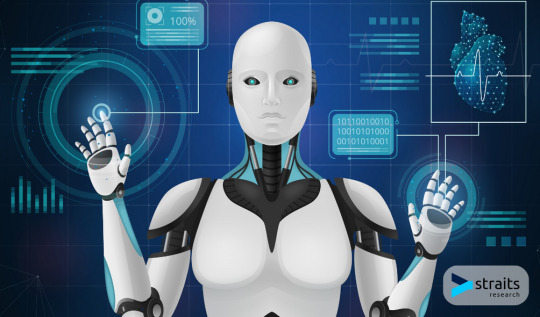
Humanoid Robot Market Research
According to Straits Research, the global humanoid robot market size was valued at USD 1.68 billion in 2023 and is projected to reach from USD 2.25 billion in 2024 to USD 23.73 billion by 2032, growing at a CAGR of 34.2% during the forecast period (2024–2032).
The Humanoid Robot market, an evolving segment in the industry, is witnessing substantial expansion fueled by avant-garde technologies and escalating consumer demand. Market analysts scrupulously gather data through polls, focus groups, and in-depth scrutiny of industry patterns. These analysts utilize both quantitative and qualitative methodologies to ensure a comprehensive and precise market report. The report encompasses intricate insights on market size, growth prospects, competitive milieu, and consumer predilections. By harnessing advanced analytical instruments and expert acumen, the report delivers invaluable recommendations and strategic guidance for stakeholders, empowering them to make enlightened decisions and seize emerging prospects within the Humanoid Robot market.
Competitive Players
The competitive landscape of the Humanoid Robot market includes several key players who have a significant impact on market dynamics. Major companies operating in this market include:
SoftBank Robotics
Honda Motor Co., Ltd.
Toyota Motor Corporation
ROBOTIS
KAWADA ROBOTICS CORPORATION
UBTECH Robotics Corp. Ltd.
HANSON ROBOTICS LTD.
Boston Dynamics
Engineered Arts
PAL Robotics
Promobot Corp.
WowWee Group Limited
Others
Get a free sample of the Humanoid Robot Market @ https://straitsresearch.com/report/humanoid-robot-market/request-sample
Humanoid Robot Market Segmentation
The comprehensive Humanoid Robot market analysis has been divided into categories such as category, application, and delivery mode, with each subset examined according to geographical segmentation. This research will keep marketers updated and assist in pinpointing target demographics for a product or service, including insights into market share.
By Type
Bipedal Humanoid Robots
Wheel-Based Humanoid Robots
Others
By Component
Hardware
Software
By Applications
Education and Research
Healthcare and Medical Assistance
Entertainment and Gaming
Personal Assistance and Companionship
Industrial and Manufacturing
Others (Military, Space)
By End-User
Healthcare Institutions
Research Institutes
Manufacturing Companies
Entertainment Companies
Others
You can check In-depth Segmentation from here: https://straitsresearch.com/report/humanoid-robot-market/segmentation
Regional Analysis
The Humanoid Robot market is studied, and market size insights and trends are offered by nation, kind, form, and application, as previously said. The report's regional analysis section provides a thorough study of many regional and national industries to help players establish successful development strategies.
Buy the Full Humanoid Robot Market Report @https://straitsresearch.com/buy-now/humanoid-robot-market
Key Highlights
The purpose of this study is to examine the manufacturers of Humanoid Robot, including profiles, primary business activities, news, sales and price, revenue, and market share.
It illustrates the market subdivided by type and application, with details on sales, price, revenue, market share, and growth rate broken down by type and application.
The research covers key regions by manufacturers, categories, and applications, including North America, Europe, Asia Pacific, the Middle East, and South America, with sales, revenue, and market share segmented by manufacturers, types, and applications.
It also investigates production costs, essential raw materials, and production methods.
Principal Motives Behind the Purchase:
To gain deep analyses of the industry and understand the commercial landscape of the global market.
To analyze production processes, key problems, and potential solutions to mitigate future issues.
To understand the most influential driving and restraining factors in the Humanoid Robot industry and their global market impact.
To gain insights into the market strategies employed by the most successful firms.
To understand the market's future and potential.
About Us:
StraitsResearch.com is a leading research and intelligence organization, specializing in research, analytics, and advisory services along with providing business insights & research reports.
Contact Us:
Email: [email protected]
Address:825 3rd Avenue, New York, NY, USA, 10022
Tel: +1 6464807505, +44 203 318 2846
#b2b#digitalmarketing#technology#trending#Humanoid Robot#Humanoid Robot Industry#Humanoid Robot Share#Humanoid Robot Size#Humanoid Robot Trends#Humanoid Robot Regional Analysis#Humanoid Robot Growth Rate
0 notes
Text
Ameca the Humanoid Robot (AI audio hooked up to a speaker in an animatronic)
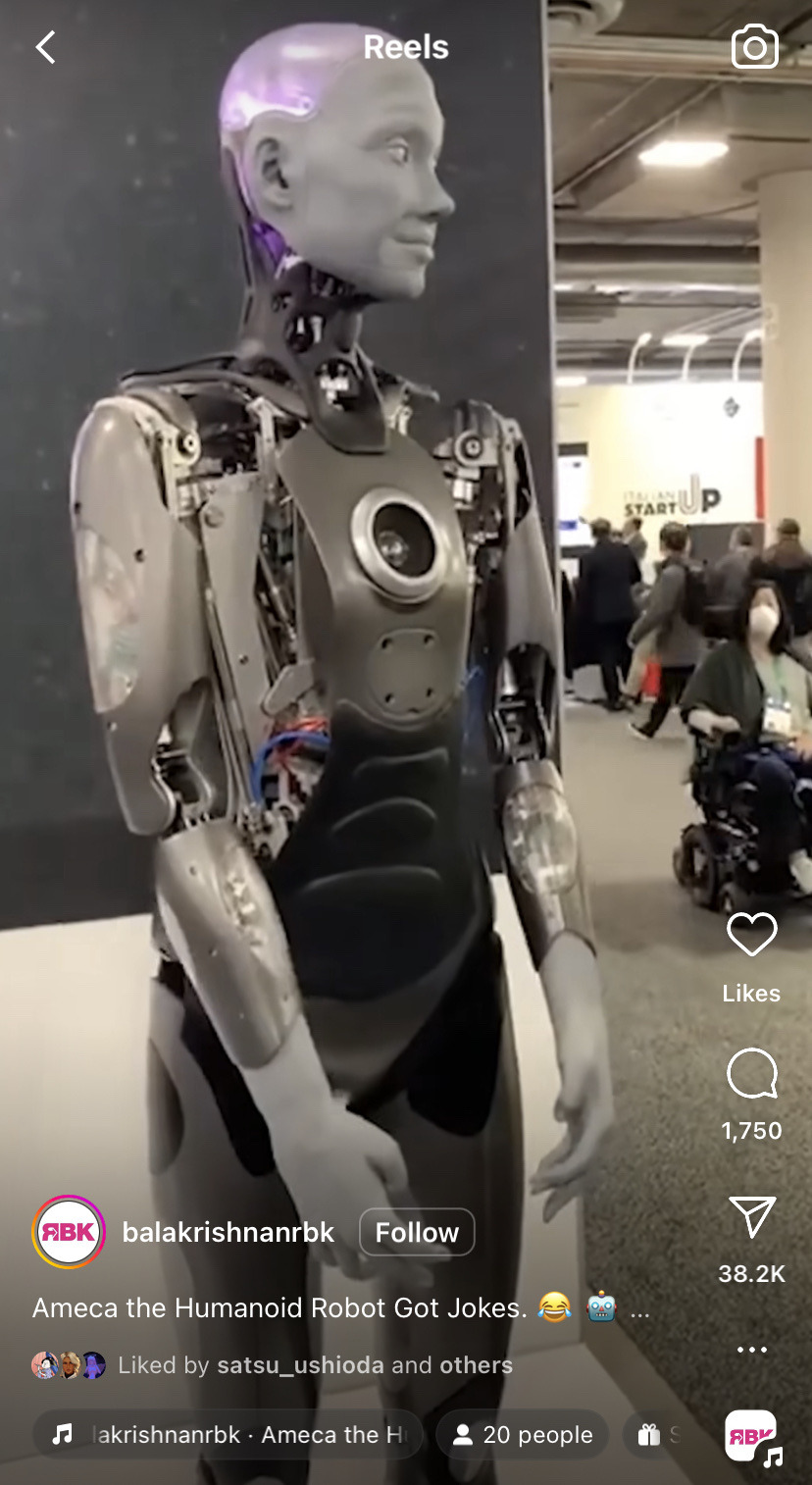
Just saw this on instagram. Naturally, the comments are either scared of the AI takeover (only when coupled with animatronics) or horny for the vaguely human animatronic (only when coupled with a femme voice)
#stop being afraid of animatronics#animatronics are not the problem#reblog for a bigger sample size#ameca the humanoid robot#Ameca#hear me out#hearmeoutworthypoll#unconventionally attractive#down bad#why she kinda#poll#polls#tumblr polls
5 notes
·
View notes
Text
Humanoid Robot Market by Biped Robots, Wheel Drive Robots, Sensors, Global Forecast to 2029
The humanoid robot market size to grow from USD 2.03 billion in 2024 and is expected to reach USD 13.25 billion by 2029, growing at a CAGR of 45.5% from 2024 to 2029. The growth is driven by the Surging demand for humanoid robots in retail industry for personal assistance.
The retail industry already uses robots in different ways across stores and warehouses, as the major applications of robots in retail are in warehouses and logistics. Humanoid robots are also highly deployed in the retail industry for serving primary robotic applications, such as in-store customer service and bringing the store to customers.
0 notes
Text
You're dating a robot girl, and she's a pretty standard model. About human sized (but shorter than you: she swapped to shorter legs for Gender reasons) but with limbs that are rectangular and her head is a CRT. You've been with her for a while and she wants you to meet her family.
Her sister is the size of an Eva. 40m, 131 feet, and she's taller than many buildings. She works in finance.
Her dad turns out to be a datacenter. He's spread across 460 servers, and doesn't really have a face or humanoid body. You talked to him on the phone a few times though. Nice guy.
Her mom used to be a UAV for the US military, but now she's working with some NGOs to try and prevent a civil war in former Soviet Belgium.
You put up with her weird family, of course. You love her, and you'll put up with some annoying in-laws for her.
2K notes
·
View notes
Text


2dmax 🌻🥀 custom art commissions
PWYW & chibi special for Fall-Winter 2024
full size art examples & sorta retro chibi examples humans, humanoids, furries, ferals, robots, anthros, etc. OK read about the conditions and how to order below 👇
thanks for reblogging!
Pay What You Want, Get What You Get Full Size Commissions 💸
Can be an icon, bust, half body, full body
Higher budget means more complexity, # of subjects, and control
Lower budgets offer more control to the artist, single subject
Working digitally/traditionally is up to the artist's discretion
Materials/stylistic choices are up to the artist's discretion
Revisions, major or minor, are up to the artist's discretion
Presence of background, scene, props, up to artist's discretion
Characters/outfits/props may be simplified or slightly altered
full size art examples -- other commission types
For reference sheets, group lineups, 18"x24" posters, paperclay dolls, or comic book pages, please see "other commission types".
$10 Sorta Retro Chibis 🎨
Single character, drawn on approx. 6" x 4 1/2" paper
Materials used are typically black and color ink
Artist controls pose, outfit, props, background, simplification
You will have a chance to approve the sketch
No revisions past that point
Tips are appreciated, but do not affect outcome
sorta retro chibi examples
How To Order & What To Expect 📬
Message me, or fill out my google form
Send me visual and/or text references
Tell me about the characters personality or special meaning to you
Include any preferences or notes on important elements
Provide payment info - for ppal please provide your email!
Provide the email address I can send the finished artwork to
I will communicate with you and confirm your request!
You will be given a link to my Trello queue
Payment is due once the sketch is confirmed
Each order takes approx. 2-7 days to complete
Delays will be mentioned on the Trello
Traditional art can be shipped at-cost
Terms and Conditions 📜
Your commission is for personal use; icons, roleplaying, in your blog theme, as a wallpaper, or to print out and tape to your fridge. Commercial use can be negotiated.
Your final art is sent over Google Drive. I will either transfer ownership or delete the file after 7 days. Please download locally.
You must credit me on the platform used if reposted. Always OK to post to ToyHouse; my username is 2dmax there. On instagram and all other platforms where I don’t have an account, please credit my instagram @/maximumgroove.
You may not use my art to promote anything hateful or illegal. You may not claim it as anyone else’s creation. You may not use it for commercial uses, or to edit, adapt, trace, or directly reference, without permission. I may use my art in my own promo material.
Unsolicited advice on my pricing or how I otherwise conduct my business is subject to a $1,000,000,000 fee via personal check, made payable to Joe Mama!
This post is LIVE from Sept 15th 2024 - January 1st 2025, with a possible slight extension.

-max k.
#2dmax commissions#art commissions#manga art#manga style art#anime art#2dmax sorta retro chibis#chibi#chibis#traditional art#cute art#artist alley#artists on tumblr#art on tumblr#character art#original art#pwyw#pwyw commissions#2dmaxcommissions
300 notes
·
View notes
Text
Ed looked up at Alan. Between everyone, the living room was already... reaching it's occupancy limit, but it didn't feel suffocating or even crowded.
It felt cozy. Warm and safe.
Ed looked up at Alan, and nodded. He turned to motion for Alan to have a seat, only to realize every seat was occupied. He awkwardly left to fetch the desk chair from his office.
Ed let a startled huff of laughter. Yes, you! he gently tapped Eve's talon on Morse code.
He turned and stared at the bowl in contemplation. Wold one be enough? Would two? Five?
Decisions were still difficult. But... Start with two, but see how things are going after the first one and add another to the queue if choose to continue with the second? he wrote on another page.
He tore it out of the notebook, folded it into an origami pigeon, and offered it to Jet.
Ed watched Eve take the little paper owl up to the bookshelf by the birdcage, and put it on top. He can't help the small hint of a smile that pulled at his lips. It was... sweet. And while the paper owl would do nothing to actually protect him, it was a reminder that he wasn't alone. And Eve would protect him.
He slowly tore out pages from the notebook while the movie played, and folded them into a variety of different birds--owls, pigeons, swans, quail, peacocks, puffins. He was going need at new notebook, but it gave him something to do with his hands, tearing out the pages was cathartic, and folding each into a tiny paper bird was calming. He'd gotten through maybe a dozen before he ended up folding and refolding the same sheet of paper, repeatedly making the same mistake as he attempted to to create an origami flamingo, each fold feeling like it required more and more energy.
Eventually Ed let his hands fall into his lap, and curled up against Jet to watch the movie, careful to make sure Eve still had space to perch on his shoulder and he didn't accidentally smash her.
He ended up just leaning against his brother and staring blankly at the screen, not really paying attention and to tired to really think or process anything.
#/* assuming Tron Yori and Beck are all still in the living room */#/* but... small-medium sized living room and Ed never really expected to have many people over at once *#/* If I have the math correct SEVEN humanoids plus an owl two robots and four pigeons */#rp#muse: ed dillinger jr#rp-041#evecolourshock
167 notes
·
View notes
Text

Heya, @niexigo! I'm your Secret Santa! I hope you enjoy this little fic focused on Moon and a little romantic moment of seeing Christmas lights together! I had so much fun writing this and I hope you enjoy! Merry Christmas! <3
Lights on the Water
Moon x Reader Word Count: ~2,000 Warnings: N/A

Winter in the city means lights. Christmas lights, of course. The LED hues have begun to pop up like poinsettias along every home and elegant crystal white displays are out in front of every store. This is the best time of year—and there is much reason to celebrate.
A lot has changed since robots, animatronics, and any machine that wished to breathe gained recognition of their sentience. The last few months have been a swirling storm. Protests and hatred bring a cold shiver around the world, but it has not stopped the evolution of new life.
You are grateful. Without the chaos, you wouldn’t be here, holding an animatronic’s hand.
Your Moon. His digits are long, painted in silver and blue hues. He cradles your mitten wrapped palm in the pocket of his silver wool coat. It’s almost comical how much bigger he is than you.
Standing well over your height, with limbs and hands to match, he engulfs you against his side in a bid to keep you warm against the December chill. You’ve seen so many models of animatronics, both humanoid and entirely machine, but Moon slots somewhere in the middle with his discus shaped head and deceptively thin limbs. His expressions are a bit more advanced, his mouth being able to move and his eyes able to crease and expand to emphasize whatever he may be saying.
You stand together at the entrance of the city park. It boasts an impressive size, with plenty of acres for dogs, joggers, and little children who need to expel vast amounts of energy from their wiggling bodies. There’s even a sizable pond featuring a bridge crossing its width and holds tiny fish and ducks—though you doubt you’ll catch a glimpse of those animals in this frozen season.
The darkness is steep even in early evening, and carries a blue tinge that seems to spread like frost through the winter. Yet, it is perfect. The lights in the distance wrapped around trees, poles, and shaped structures are warm beacons.
You lift your free hand to tug on Moon’s scarf. The silver and deep blue stripes wrap snugly around his spindly neck, but you fear the cool air might be hard on his inner workings. It is well below freezing. He tilts his head. His nightcap swings softly over his shoulder with a soft trinkle of a bell. The low glow of his red optics softens upon you.
“My internal regulation is a lot more advanced than yours,” he rasps, touched with mirth.
“I know that, but you weren’t built to be outdoors.” You tuck one end of the scarf into his wool coat. The thick and warm material reassures you while your fingertips are seized by the bitter cold air. “Let me know if you need anything, okay? A kiss to warm your cheek, an embrace to melt any ice in your system. As a human, I am naturally above the freezing temperature, and at your service.”
His scarlet-hued gaze crinkles in humor. He lifts a hand. Though you’ve found that he tends to run cool (thanks to his advanced internal regulation system) he can warm himself up to a decree that makes it all too easy for you to fall asleep in his arms on movie nights.
“Hm, yes, you are very rosy-cheeked,” Moon murmurs. He palms your cheek, and your eyelids immediately flutter against the blissful heat of his touch. “Whatever would I do without my darling human to save me?”
“You’d freeze and become a pole or something. They might hang wreaths on you.” You snort at your own joke.
“Har har,” he says dryly. “Snowball, leave the comedy to me.”
You lean deeper into his touch. His thumb caresses softly along your face, drawing underneath your eye before sweeping back a strand of hair that fell out of your beanie. This close, his optics dust you in a soft red glow.
Your favorite color of late has been red. His red eyes. The red ribbons he ties around his wrists with golden bells. The red ruffles around his neck. He’s bundled now, but he still looks at you with the scarlet light that makes you melt.
“Come on. The lights aren’t going to see themselves.” You force yourself to straighten out of the delicious comfort of his temperature. He chuckles, a mischievous sound that now fills you with a giddiness.
“Lead the way, Rudolph.” He boops your nose and turns to the entrance. Though, he doesn’t take a step without gathering your hand back in his and setting it within the safe confines of his coat pocket. He squeezes your palm once. You squeeze back.
He’s never seen the lights before. He told you this once as the holiday season approached, and it appalled you. Of course, how could he have seen any Christmas decorations and displays outside of the Freddy Fazbear Mega Pizzaplex? From what he’s told you, and from what you’ve gathered out of his selected details, the work conditions were not humane. Why would they be for machines? But regardless, you made him a promise, and he shared his enthusiasm.
Through the twinkling blue evening, you and him stroll inside the park. The very first lights are trees engulfed in lights. One purple, one yellow, one green, one red. You have not the foggiest idea how painstakingly long it must take to wrap each bough and the whole trunk of the tree until it’s a blazing torch in the night. The path winds softly through the burning bright trees.
Moon turns his face up towards the light. You subtly watch him from the corner of your eyes, trying to study his reaction without making him feel like the focus of your attention. You’ve visited the park many times over the years to see the lights. Your only hope is that he finds it as beautiful as you do.
His optics are low in comparison to the bright bulbs. The light beams onto his faceplate, highlighting the curve of his shadowy crescent and coloring his pale other half. It catches on his cheeks. His teeth grin but there is a glimmering awe to the edge of his constant smile.
You hold his arm, your other hand still smugly dipped into his pocket.
“There’s so much more,” you whisper to him, “but it’s pretty, don’t you think?”
“Yeah, pretty,” he answers in a gentle crackle of static.
He turns to look down at you. He stops a moment, and stares. You blink. Is there something on your face?
His expression softens before he pecks your cheek with a kiss.
“Come on,” he tugs you further down the path, “There’s more, right?”
Your face heats not simply due to the warmth of his mouth. The tip of your boot almost snags on your other leg as you try to step in time with him. In a hot haze, you force yourself to inhale a great frosty breath and bring yourself back into focus.
The animatronic knows exactly what he’s doing to you.
Deeper into the park, the displays begin popping up along the path. Instead of twinning around trees and filling the fronds like a forest fire, the lights take shapes after candy canes, reindeer, snowflakes, and Santa’s sleigh.
“The kids would love this,” Moon says as you pass by a golden row of bows and ribbons twisting down the sidewalk. His job as Daycare Attendant remains a preference of his. The daycare he owns and runs, no longer attached to the Fazbear name, is just down the road from your apartment and his.
“Oh yeah, I always see families here,” you nod. You two arrived later—after the early rush in the hope of not being crowded and forced to move quickly to let others have their turn. It seems to be working for the most part.
He hums thoughtfully while continuing down to a section dedicated to Christmas toys. An elephant with polka dots and a dolly with red braids and blue bows in her hair smile at you and Moon walking along.
You shiver once. Your poor fingers are exposed to the elements, even with the defense of a glove, and suffering. A low chuckle emits from Moon. Before you can protest, he steps around your, freeing your one hand to stuff the other into his coat pocket.
“What will humans become if they freeze?” he asks, deadpan. You pull a face at him. He breezes past your pout. “Popsicles? I could sprinkle sugar on you.”
“Ew,” you say, but laugh. “But probably. A human popsicle sounds about right.”
“Sorry, but I can’t let that happen,” Moon shakes his head. “You fragile humans.”
“Not fragile,” you announce, but he pulls your beanie down over your ears all the same.
The display continues into a little north pole display featuring polar bears and igloos and sliding penguins. (You’re pretty sure penguins don’t live in the north pole, but who are you to criticize art?) Moon points out an ice fishing hole. You ask if he has any wanderlust for the great outdoors. He pauses and considers that he might want to experience a camping trip, but that’s more of Sun’s thing.
You make a mental note of that.
The path darkens as it winds further along. Moon walks closely beside you. His stride is considerably slower, thanks in part to you and your comparatively short legs. He doesn’t seem to mind. His digits interlock between your fingers. Cradling your hand, you sight at the sweet relief of his warmth easing the numbing sting of the cold. Your other hand, however, is beginning to freeze once more.
You can hold out. You’re not fragile. No matter how much Moon likes to tease.
Around the bend, the path lowers into a curving circle around a great pond. Moon lingers in the slightest as you watch him again. His eyes roam over the floating lights set in the shape of trees upon the water. The colors gleam and dance along the surface, reflecting yellow, red, silver, and soft blues in a bright effect.
“This is my favorite,” you say softly into his shoulder.
He dips his head closer to you, though his eyes don’t wander from the beautiful displays. The twinkling lights reflect off of the water. You tug Moon further along the path following the edge of the water. Walking slowly, you allow him to drink in full view, enjoying the peaceful calm of a winter’s night with such warm lights.
“Beautiful,” Moon says once you finish a full loop around the pond.
You make a soft sound of content and lean closer against him. He releases your hand to wrap an arm around your shoulder and tug you in close. For a blissful heartbeat, you both watch the dazzling display, two mirrored versions of lights divided only by the waterline.
Moon suddenly laughs. You lift your head up in confusion to stare at him.
“You’re shivering.” He squeezes you a little tighter into his embrace. Indeed, once pressed against his wool coat, you realize your muscles are working hard to bring your body’s temperature back up.
“I’m fine,” you say, but pause, “They always sell hot chocolate at the very end of the path.”
“Alright,” he turns and lowers himself to you. He smuggles softly against your neck, and you breathe out in solace as the heat of his faceplate finds the cooled parts of your skin just under your chin. “Let’s get you some hot chocolate, then I’ll take you home.”
“Sounds good,” you murmur, your jawline bumping against his nightcap slightly.
Moon rubs your shoulders in soothing circles, his heat slipping through your coat.
“Thank you,” he murmurs.
You smile though he cannot see it.
“Your welcome, sweetheart.” You think for a moment. “Does that mean you had a good time?”
“I did, and I still am,” he straightens. His grin is gentle in the darkness. The red of his eyes fills you with a molten adoration. “I think we should get going before you become a human popsicle.”
“Yeah, yeah,” you try to wave away his concern. You, however, grab his hand and press it to your mouth. Your kiss holds softly to his palm. His fingers curl gently against your cheek.
“Merry Christmas, Moon,” you whisper once you release his hand.
“Merry Christmas, snowdrop,” he answers in kind.
113 notes
·
View notes
Text
Voya-Nui: An Overview
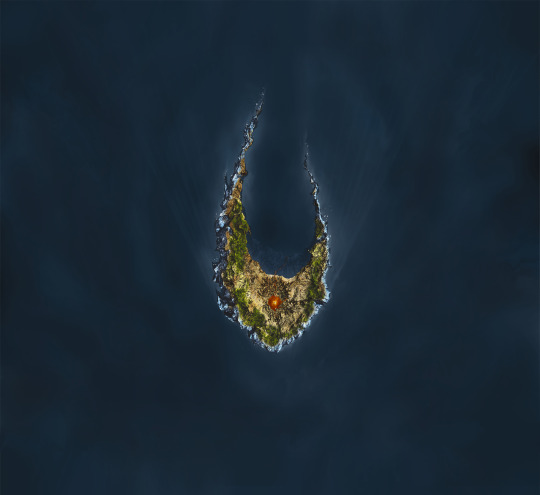
Hello,
This will be somewhat similar to my 1/10th scale Mata Nui posts, discussing the floating island of Voya-Nui based upon recently revealed information, mainly dealing with its size and role in the initial story.

Warning, this post is embarrassingly long.
Any who have the misfortune of knowing me know I have a rather selective view of what constitutes Bionicle. Essentially I consider Bionicle to have run from 1998 to mid 2002. As a kid I was a die hard fan until 06, where a combination of the marketing and the sets just not being very good caused me to gradually lose interest until I just got one set in 07 and never again bought a Bionicle.
All this preamble is to say that for the longest time I never really knew all that much about Voya-Nui, apart from it being the namesake of a terrible game. Later on, as I got back in to the hobby I heard rumors, dark, twisted rumors. They spoke of a stick making the island fly underwater through a hole, that the island itself was ejected from the body of the robot and left a Voya-Nui sized hole in a continent. Just the ravings of a mad man, so I threw it in the bin along with everything in Bionicle after the Toa go in to the Bohrok hives in 02 and moved on with my life.
Fast forward to now, and Christian Faber starts releasing some development materials through a humanoid water fowl, and this very interesting image is among what's released
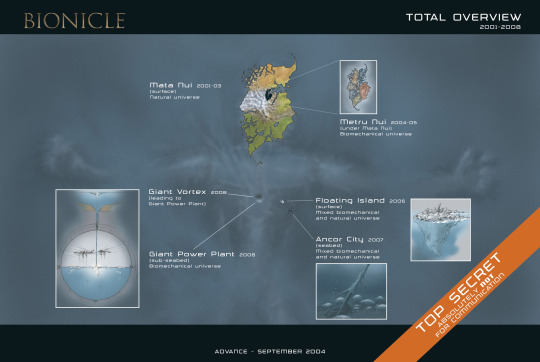
This image made everything click for me and I fell in love with Voya-Nui as a concept.
But I think before revealing the original intent, its important to explain the "canon" sequence of events surrounding the so called "Island of Doom"
ISLAND OF DOOM, A PRIMER
Okay so there's a big robot sleeping in an ocean, one day its heart pops and a chunk of land that was on top of the heart breaks out of its chest and starts floating in the ocean. The island, I must add, survived this event, as the hole it left is the same shape and size as the final island.
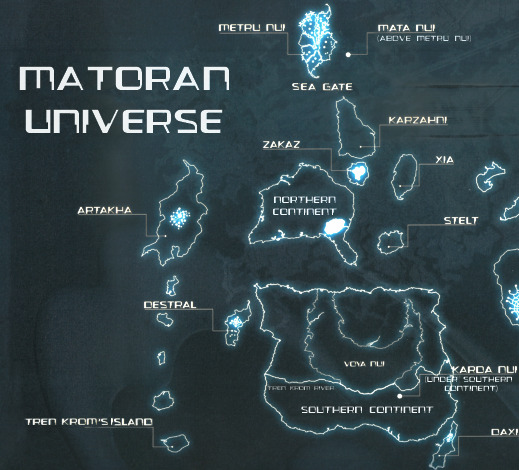
Now the island floats around for a bit, the volcanic crater on it eventually builds up a large land mass in the middle of the bay, the people on it (yes there were people on the island when it got ejected, and they survived the event) decide that this is the best place to build a city.
It turns out that wasn't the best place to build a city as the new land mass breaks off and somehow anchors it to the sea floor.
Eventually some guys show up and break the anchor cord and the island, inexplicably, sinks down under the water, and manages to go right back in to the hole it made and everything returns to normal.

In some blog post it was explained that there was a magic wand that fixed everything that was used at the same moment.
This is the canonical sequence of events.
More like island of dumb¹.
THE ORIGINAL CONCEPTS
Okay now that all that unpleasantness is out of the way, we can start with the actually interesting things.
There are so many details to cover here, I think the best way to organise them would be to present everything roughly chronologically.
The scenario is the same, a massive robot crash lands in a large ocean, its completely under the water outside of its face, upon which the larger island of Mata Nui forms.
From the beginning its very different, there's no large landmass over the heart (in fact the very idea of the robot itself being full of various domes with islands in them is very suspect but this post is already long enough). The heart is a reactor, and consists of a massive spherical cavity in the chest. Something occurs and the heart pops open, a small panel or valve on the perimeter of the reactor core's wall bursts out of the chest of the robot. Through this hole sea water begins to flood in-this is important!

The ejected panel floats, and some sort of system within it cools it down, causing the sea water to freeze, essentially turning it in to a massive iceberg. There's also mentions of it being magnetic, the final island is described as looking somewhat like a magnet run over a factory floor. It probably also attracted debris from the sea bed as it floated through the seas. As you can see in that diagram the core is filled with massive long cables and the island eventually gets anchored by a long cable, so that's possibly where that came from!

Over years the island grows and grows as it floats around the oceans, being buffeted around by the currents. Eventually part of it becomes unstable and breaks off, sinking to the ocean floor, and since a large cable was attached to both pieces, it anchors the island in place.
Now we get to the crucial part. In the canon depiction of events the most baffling thing is why does breaking the anchor rope make it sink? Now we come back to this image:

When the panel popped out it left a hole. Water is pouring back in to the hole, forming a giant whirlpool. The robot is so massive that even after all these years of constant flooding the cavity on the inside is still not even half full. Voya-Nui was caught in the whirlpool's strong currents when the island broke up. This impromptu anchor stopped it just as it was about be pulled in! Then the super strong currents from the whirlpool gave it the distinctive curved shape.
So now we know why destroying the cable holding it in place causes the floating island to sink: once untethered its free to be pulled in to the whirlpool! The island that formed around the panel would break off and the panel would basically be a giant plug and stop the flow of water flooding in to the reactor.
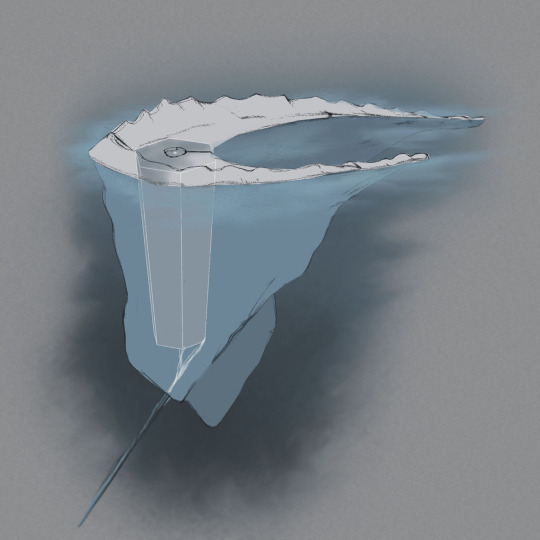
Figuring this all out was such a revelation, taking one of the most nonsensical sequences of events in the series and transforming it in to this completely logical scenario which, from the point of view of the characters involved, is still quite mysterious and oblique, but when looked at from the perspective of repairing this giant robot it makes perfect sense.
And we were robbed. Imagine the Mata Nui rising sequence of animations starting off with a whole island being pulled in to a whirlpool.
THE CORE
This is getting a bit beyond the main focus of the island, but I just want to talk about the core itself because there were a few interesting tidbits there as well. Its a very evocative setting which I feel suffered greatly and few of the interesting parts were conveyed well in the story.
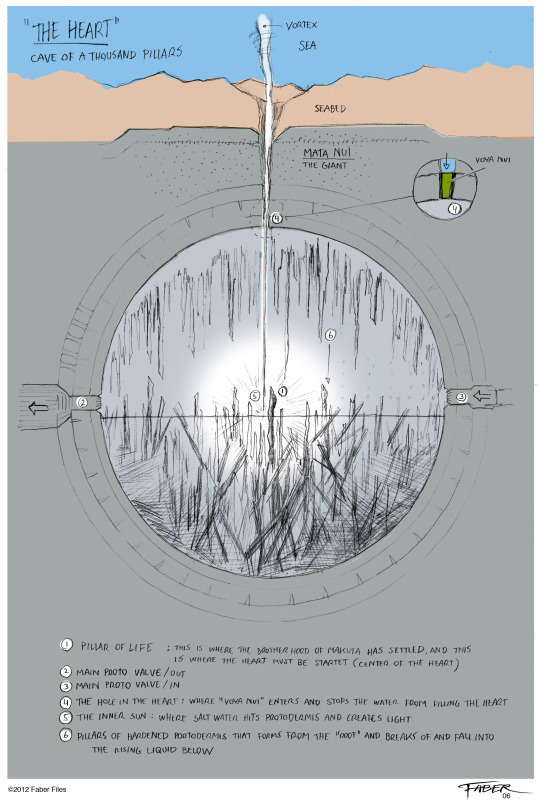
The water streaming through the hole is described as having some sort of light emitting reaction to the part of the reactor its hitting, lighting the whole chamber. Steam from the reaction swirls upwards and vaporised materials from the heat of the reaction collect on the roof, forming massive stalactites that eventually fall, creating this jagged forest of stone needles within the massive pool of water, water which's temperature varies depending on how close it is to the reaction.

Really seems a shame that in the final story it was simplified down to "sky" and "swamp". Just imagine, this forest of stone, shrouded in fog, lit by this flickering unearthly light emanating from the centre. You have the added aspect of once Voya-Nui has returned to its rightful place the water fall would cease, leading to the light dwindling until the whole area is pitch black.
MISCELLANEOUS OTHER NOTES

One major feature of the island that was missing from the earlier ice and rock version is the massive lava crater, supposedly from the mask of life². I had been toying with the idea that the volcano formed the rest of the island around the panel, but with how much larger the island was it just didn't make sense, so the ice and magnetism really helped out there!
Its said that the ice formed as some sort of self defence mechanism, like an organ freezing itself to preserve itself in an emergency. Personally though I have this little idea that the panel was actually something like the cooling system for the reactor, and without it the reactor was going to over heat, but luckily it was kept just cool enough by the falling water. The cooling system, being linked somehow to the main robot, detects that the reactor was over heating and starts working over time to cool it, leading to it freezing the surrounding ocean and making itself in to a massive iceberg, but as it wasn't connected to the robot's core and nothing it did had any effect, it ends up overheating itself, causing the pool of lava on the top. But that's just a little fan idea.
Another one I have is that the island, when it was floating freely, may have passed next to Mata Nui, close enough to be sailed too, at some point far in the past. Explaining how there would be inhabitants on it despite it getting shot out of the robot like a bullet.
Also it would be remiss of me to not mention that even though the canon depiction of events makes no sense, the whirlpool is briefly seen in the 100% ending of the torture device Bionicle Heroes.

But this is much smaller, and seems to only have just opened up in the bay. Rather than being something to do with the hole it made it seems this is more about how the mask they were seeking went underwater.
SCALE!
Time to talk sizes!³
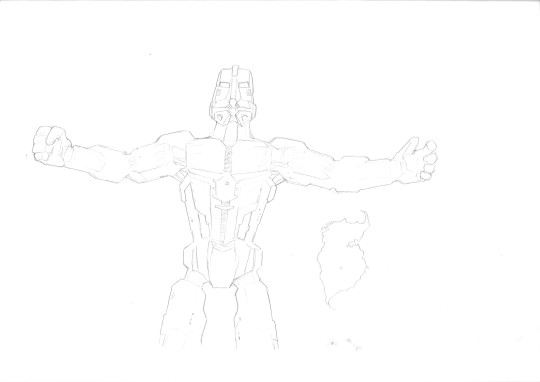
This drawing is especially useful here, as it shows all 3 major objects in question all relative to each other. Yes Voya-Nui is there, its the tiny little dot on the bottom right. So I simply took the height maps for Voya-Nui, used them to make a quick little model in the same fashion as my Mata Nui, and brought in my old GSR model. I scaled them all to the Mata Nui from my last posts, and guess what! It all lines up perfectly.

The Voya-Nui Model is the exact right size it should be, according to this map:

And what was more impressive, was that the GSR turned out to be pretty much bang on with this even older concept art:
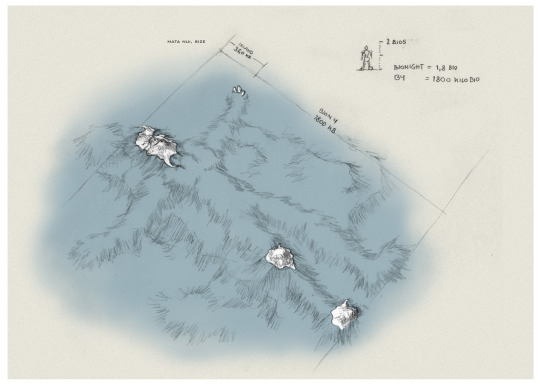
Scaling the GSR was a more bit awkward, as the final design is more gangly compared to this drawing, but lining up the torsos worked really well!
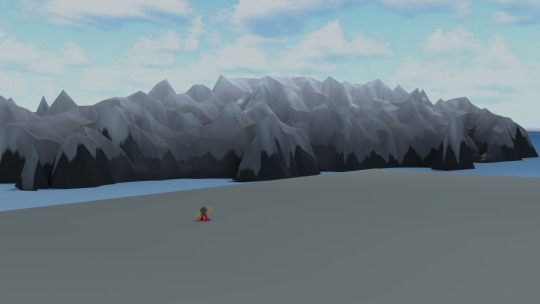
And now let us visit the 1/10th scale Mata Nui and meet Geroge. A new island has floated up off Ta-Wahi beach and he want's to explore a bit!

Excuse the monochrome island, the height maps I'm using are actually quite different from the final island.

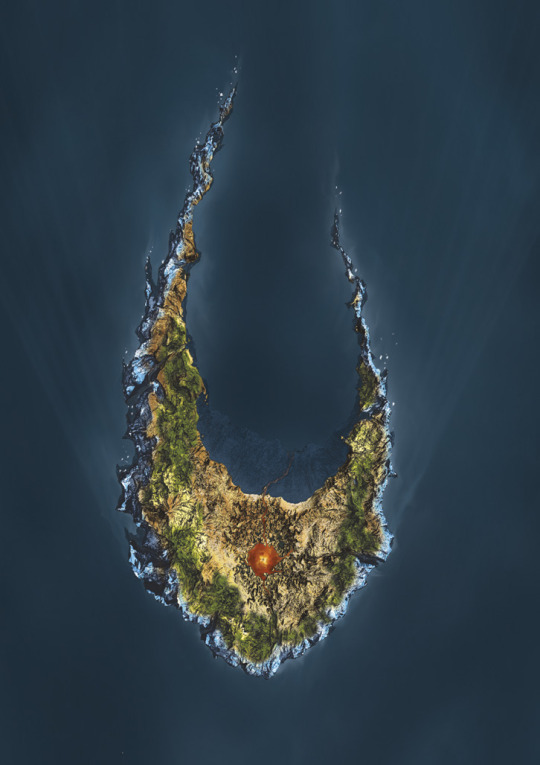
There is a height map more accurate to the final island, but that one didn't have an underside. The little islets in the bay were also neat.
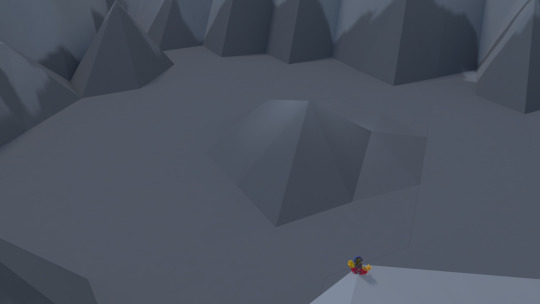
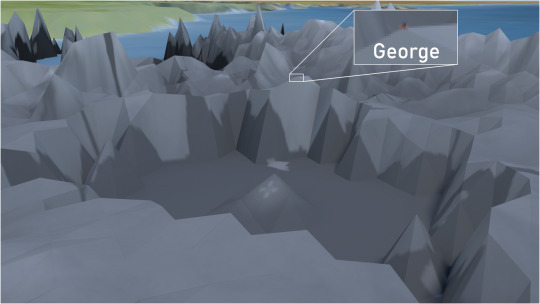
The large lava lake in the centre is roughly 250 metres across. Its nothing compared to Mata Nui's caldera, but its still very huge when you get down to the ground level.
The panel that forms the centre of the island is massive as well.

Approximately 550m wide, and 900m tall. Just think of the massive reactor core this thing popped out of!

Seeing it separate from the island really puts it in perspective.
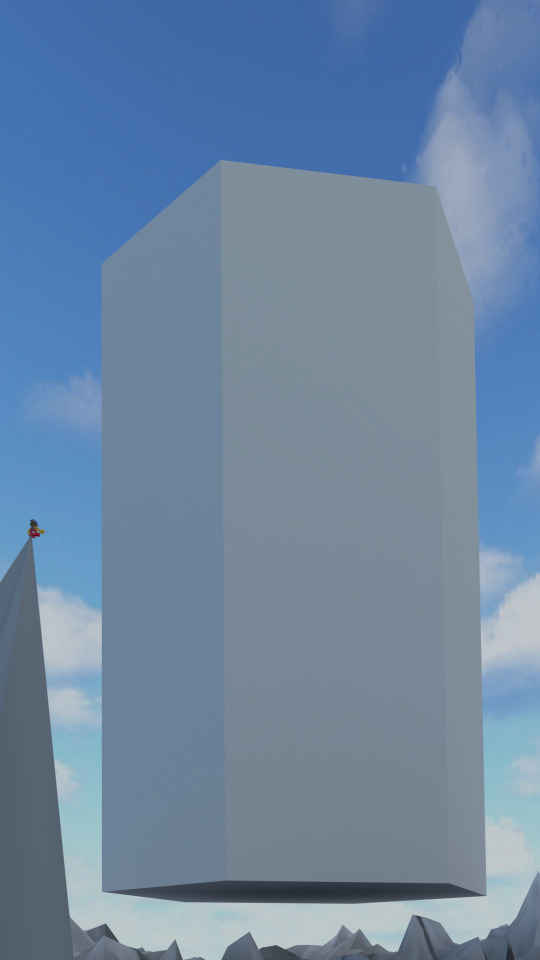
Imagine this thing shooting out of the robot's chest like a bullet.
I'll just quickly mention, earlier on I posted that map of all the internal islands. If you use the size of metru nui on there you can scale Voya-Nui appropriately, and you end up with this.

Its less a small panel popping out of the heart and more the scene from Alien at this point.
CONCLUSION
This has been quite a rambly post, but there was just so much information to cover. I left out a lot of details. This whole thing just makes me very excited, sorry.
I just think its such a beautifully elegant scenario that really adds a lot to the setting and story, rather than just having yet another new island, but this time the island is mean. I find it quite interesting how everything would have sorted itself out, if not for the island breaking in half. There's no Machiavellian plots, no scheming, no betrayal, just an unfortunate occurrence that makes a bad situation worse, and everyone has to work to fix it. It was utterly butchered in the final story. It makes me quite sad for what could have been. Just picture it, this floating island getting pulled towards a massive whirlpool, the outer island breaking off as it spirals deep down underwater until this long, tarnished metal plug is revealed to have been at the centre. With a huge impact it closes up the hole, fitting back perfectly where it came from, managing to avert the disaster of the flood waters growing ever higher inside the core of this robot.
But in any case, really the important take away is, Voya-Nui is just a rip off of Noah's Island when you get down to it.
I'll leave you with a photograph of George waving hello to his large friend.

Have a nice day/night[delete whichever is inappropriate]!
¹-You know its true. ²-Not to be confused with the Mask o' Flight, the film staring a swarm of Tahnok. ³-Please note, I am using 1 kio = .1 km as per my previous posts, if this offends you simply multiply every number in this post by 43.75966487787¾⁴ ⁴-Yes even this one.
While I was working on this I made some more revelations about the core which will probably need its own post. ;_; This thing already took 3 days to make....
#Bionicle#hypothesis#writeup#Mata Nui#Voya Nui#Great Spirit Robot#I managed to do this whole thing with only mentioning the characters of the story twice :)#quack
126 notes
·
View notes
Text
Rozfink general headcanons
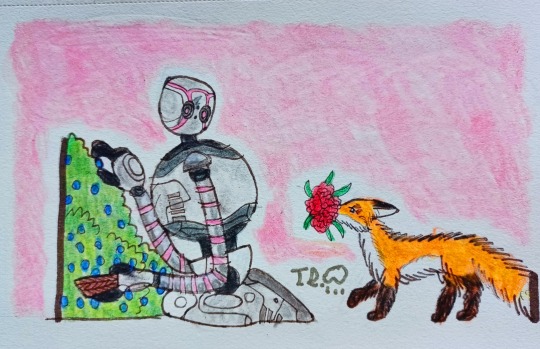
At first glance, this is understandably a bizarre pairing. Two completely different species and lifeforms. The uncertain legality of this ship certainly doesn't help. A robot who's a fish out of water and a fox with some underlying trauma. They're the type of couple where you don't know they're dating unless they tell you. Their rare moments of pda are truly a blink or you'll miss it events.
Boy, the romance between these two is one hell of a slow burn. How slow is this slowburn? They raised a child till adulthood for almost a year together and yet neither still had the courage to confess to each other. Seriously, they have a complicated situationship where they're between the thin line of friends and lovers. Roz is just getting the hang of emotions and Fink has started opening up to others. Fink would be the first to realize his feelings. There is no overly dramatic confession scene with hearts & sparkles in the air. Instead, they both just quietly acknowledged each other's feelings.
Roz and Fink never really consider each other as "boyfriend & girlfriend" or "husband and wife". They don't believe labels are necessary for their relationship. They just find their love for each other enough to be valid as a connection. Even after their love confession, they still at best usually refer to each other as "partners". However, they occasionally use petnames (such as "dear" & "darling") and don't mind others calling them "mates".
Roz's love language to give are acts of service. As a robot, she generally has trouble processing and expressing emotions. Serving others is in her programming-so she'll want to show Fink how much she cares for him by helping him in any way she could. This can range from housekeeping, baths and even the smallest things like finding comfy new straw for him to sleep on. Whenever Fink gets sick, she'll go into nursing mode. The love language Roz loves receiving are words of affirmation. She'll be highly pleased whenever she gets praise & expressed gratitude for her services. Fink makes sure to never run short on expressing appreciation for everything Roz does.
Fink's love language are physical touch. Before meeting Roz, he's hated by mostly everyone on the island and he hates most of them back. He's an isolated individual who could only best express though actions instead of words. Typically, foxes express physical affection by cuddles, grooming, biting, playing and nose rubbings. Fink would only express the following with individuals close and dear to him. Fink loves receiving physical touch just as much as he expresses it. The bulletin point after the next following one will go into this point further.
Due to their completely differing physical forms (along with their drastic size difference), these two have to be creative about expressing physical affection. Roz either would have to crutch down or Fink has to take a ride on her shoulders. Roz obviously doesn't have a mouth-so she unfortunately, can't kiss. Fink ofc can't express affection the same way humanoids could. So, as an alternative to kissing, the two would nuzzle their heads together. The first time they hugged, Roz almost crushed Fink's bones by accident (she nearly forgot to control her strength at that moment). Like I said earlier, their pdas are usually quick & discreet whenever no one's looking.
Fink believes that Roz gives the best belly rubs. Ever. And massages too. He also loves receiving nose boops, pats on the head and cuddles/hugs. In particular, he loves to nuzzle his head close to Roz's neck. On the flipside, Roz loves it when Fink gently presses his snout in the center of her face. She finds it cute whenever Fink rubs his head on her body. She'll briefly stop functioning whenever Fink licks any part of her face (and her neck).
As adoptive parents without a strong support system, Roz & Fink rarely have time to themselves, let alone dates. As much as they love raising & caring for Brightbill together, they occasionally wished to have time without worrying about parenting. However, they know that almost no one on the island would be willing to babysit or be safe as a babysitter. It can be easy to lose individuality since everyone on the island knows them as parents than individuals.
One of their favorite spots on the island is for sure the cliff side. In the daytime, they can witness the entire island from that view and watch the sunset together. At night, they'll be closer to the stars to stargaze. Sometimes, they'll peacefully rest there together under the stars and wake up to watch the sunrise. This spot is where Fink & Roz confessed each other's feelings.
With such contrasting personalities, Roz & Fink are bound to have some bumps on the road, especially in regards to parenting. Whenever they have a disagreement, they'll usually try to be civil as much as possible mainly for Brightbill's sake. If they feel a disagreement could escalate, they'll have the discussion when Brightbill as asleep for the night. They'll even take it outside so that Birghtbill couldn't hear them. This was especially prevalent when Birghtbill was a chick since neither have experience in parenting, let alone parenting together. As Brightbill got older, these disagreements became less frequent.
Brightbill is obviously the first supporter of the relationship (with Paddler & Pinktail being secondary). Him bringing Roz & Fink together as a couple is purely unintentional. Brightbill never questioned his parent's relationship until he migrated for the first time. One of the reasons he initially resented the animals on the island is because of the uncalled for remarks about his parent's relationship. During migration, Brightbill almost had a physical altercation with another goose who said that it's a "blessing" that his parents can't procreate together.
Due to being completely different species with a not-so positive reputation (Roz being ostracized more than Fink), many animals on the island initially disapprove of their relationship. Although Roz & Fink never outright tell others about their relationship, it doesn't take long for others to put the pieces together and for nasty rumors to spread. From time to time, Roz & Fink would hear others whisper in hush tones vile gossip about them. Some of the animals even went as far as to vocalize their disdain for their relationship right in front of their face (often resulting in Roz having to hold back Fink from attacking the naysayers). Notably, some of Fink's own kind feigned pity for him, saying that he's "desperate" to have a "monster" as his mate since no vixen wants him. It's a slow process for other animals to be at least tolerant about their relationship.
Fink and Brightbill are the last animals Roz ever talked to ever before leaving the island. Fink & Roz didn't officially break up per say. They more so put their relationship on hold for now. The night Roz left, Fink was quite heartbroken. He didn't think it's ever possible to have someone who loves him in this way. He & Brightbill consoled each other. However, sharing their favorite memories with each other about Roz is what inspired Fink to share the story about Roz throughout the island.
#the wild robot#dreamworks animation#dreamworks#rozzum unit 7134#fink the fox#fink x roz#roz x fink#rozfink
129 notes
·
View notes
Note
Remy I miss you I love you also. Titus. I love him and miss him. And also Nightlight reader. Babies. Beloved.
[I had am old blurbo with Nightlight and Titus I scrapped. Here's one for him and Remmy too]
Remmy finding Nightlight Reader at a thrift store while looking for more dolls to add to his collection of antiques. They're the most beautiful "doll" he's never seen- (anything that has a humanoid form and is made of plastic, wood, cotton is a doll to Remmy- even androids). He takes the android home - planning to clean them up and give them a comfortable spot in his room. When Remmy touches the heart on their chest-
"Powering on.......backup battery at 12% percent....Accessing memory...No memories found... error...error...err-"
"Ah!.. That was scary. Hm, where did I end up now? Oh! Hello, tiny person - are you my new owner?"
Remmy instantly falls in love seeing this robot pick up on the dolls on his bed and speaking to it as a normal person. "Um, actually..I think that's me."
"Whoa! Where did you come from? My apologies, owner - what should I call you?
Remmy falls more in love with Nightlight by the second. They're so caring, and warm, and they love to play with his dolls as much as he does. They would follow his every command as part of their programming, but Remmy hardly feels the need to order them around because he knows they'll never leave him and for that he'd do anything from them. Stays awake all night until nightlight carries him to bed making new clothes for them. Buys all the books he needs to repair any minor damages they might have - and completely erase any trace of their memories of the past.
All Remmy needs is Nightlight. All Nightlight needs is Remmy.
-
Titus is given Nightlight Reader as a present from his guards after finding the android in a landfill on earth and repairing them to working order- The emperor has been more irritable than usual- if he dislikes this bot, his guards pray that smashing them to bits will be enough to quell his anger at least for a time. The guards present the android to their king and wait-
"What have you brought to bore me with now?'
"We believe it is an earth made machine designed to relieve stress for humans-"
The emperor chuckles. "Is that so?~ I have been rather pent up recently, and it isn't a complete eyesore, but you are aware of our difference in size, yes? Are you certain it won't break on first use?"
"Er, not in that exact way, your highness. You see, they-"
Titus huffs. "Then what good is it?"
"Just....allow me to turn them on. Please place your finger on their heart, your highness."
"This is ridiculous...."
The emperor does as instructed
"Powering on....Battery at 100%...System rebooting."
"Mm....Huh? What a strange place... Are you my new own..er? Oh, owner- your stress levels are dangerously high - they're increasing by the second! Why won't I sing you a lullaby while you relax with your favorite drink? I know lots, but I can always make up new ones - maybe one about your pretty eyes."
"That..... actually sounds wonderful. I haven't had a decent night of rest in ages. It's humorous to me how you were able to figure that out in seconds when these fools have been with me for centuries. I think I'm going to enjoy your company more than I thought."
Titus cannot go or sleep anywhere which his little nightlight. Feeling their heated, smaller form is all thats needed to knock him out like a light. Nightlight Reader is restricted from joining Titus in meetings for that sole reason. This whole ass tyrant sits in his chair pouting like a child until he can reunite with his little love. Decorates them like the doll they are with jewelry and adorable outfits. Whenever Titus is in one of his rages, guards quickly run off to retrieve nightlight from wherever they're exploring in the palace
#yandere#yandere imagines#yandere headcanons#yandere x reader#yandere blurb#yandere insert#yandere x you#yandere scenarios#yandere oc#male yandere#Remmy my oc#Titus my oc#Yan
307 notes
·
View notes
Note
OK, I have a personal headcannon that the turtles are super tall- like- raph is 10f ish, Donnie 8ft, leo a little shorter, and Mikey is at LEAST 6ft.
So the turtles interacting with the world being tall mf's and as well as their s/o (like throwing them over their shoulder or air jailing them
Bounus points is S/O is short by normal standards.
THIS IS NOT MENT TO BE SMUT. At all. I request wholesome and Mischievous content.
Well wishes: SBF🐍
[ Ankle Biter ]

Future!ROTTMNT x GN!Reader who is short
A/N: i assume you meant the future turts? im so sorry if this is wrong! we're gonna assume the reader is between 5'0 - 5'3! thank you for requesting SBF!! <3
Relationship: Romantic
TW: Fluff, kisses, cuddling, slight panic (?), affectionate teasing.

Future Raph
He adores your short size.
Hug? You get a bear hug regardless of how gentle he is.
Cuddling? No, weighted blanket in the form of a humanoid turtle.
Kisses? He has to bend over or pick you up to do so.
He gets a little anxious in crowds.
Being so tall means you can see everyone so, you'll be easy to spot, right?
No, not when everyone blurs together.
He once lost you at a festival and...
It was not pretty for the other turtles.
Certainly. Not pretty.
Future Leo
One word.
Air jail.
Your crimes are condemned to punishment, being held like a soggy cat for 5 minutes.
You are also an arm extension.
Something (surprisingly) too high to grab?
Fetch it for him.
If you guys are hanging out with shared friends, he ALWAYS has to sweep you of your feet.
Show-off.
That is until you start to rebel.
When you start to rebel, the only thing Leo can do is pray.
Future Donnie
Height doesn't really affect you two.
Kisses are a little harder but, Donnie is flexible.
Plus, carrying all those junkyard scraps beefed him up a little.
Along with training and fighting.
However, he doesn't hesitate to bring up your height in banter.
"I'm not sure how your opinion matters when you still aren't fully grown. Oh wait, you are."
Simply uses his robotic arms to shove you away once he gets your temper going.
Aside from that, he thinks its a convivence that you are short.
He's making something for you? Less materials used compared to his brothers.
He's also more lenient on repairs or replacements when it comes to you for the same reasons.
Future Mikey
Lets be real, if anyone is gonna tease you the most, it's Mikey.
Backtalk? On top of the fridge you go.
"Are you sure you don't need a stool to see? Just making sure."
He is so smug about it.
Growing up the shortest, it's funny to see the tables turn on someone else.
But he makes sure to never go to far, no feelings will be wounded by Dr. Feelings himself.
He really likes you on his shoulders, a simple lean and it's easy to kiss you.
Nicknames. It's always the nicknames.
With the teasing also comes the politeness.
Doors opened for you, stuff moved out the way, he can't have the ankle biter themself getting hurt!

#rise donatello x reader#rise michelangelo x reader#rise raphael x reader#rise leonardo x reader#rise donnie x reader#rise leo x reader#rise mikey x reader#future donnie x reader#future raph x reader#future leo x reader#future mikey x reader#rottmnt x reader#rottmnt#rise of the tmnt#rise tmnt#rise of tmnt#2018 tmnt#tmnt 2018#save rottmnt#unpause rottmnt#rise of the teenage mutant ninja turtles
392 notes
·
View notes
Text
"How realistic are mecha, really?": They aren't, but not for the reason you're thinking of or the one adjacent to it. Trust me.
Crossposted from reddit, since people seemed to like it. Like in the thread, I am very happy to answer questions about any esoteric weirdness.
Hold my beer. Again
They're not becoming a possibility. Yes. I know. This sucks. But stick around. Its not for the reasons you think. Well it is, but it also isn't. You'll see.
The robot needs the technology more than the technology needs a robot.
the technologies which the robot needs will improve and alter the doctrine of every other platform
This creates a doctrinal lock-in where the potential functional space for them to exist is unmet -- that they are so far ahead, that nothing new can emerge that isn't just other platforms becoming more generalized (eg, a post-stall recovery aircraft, or a helicopter with high impact landing-gear and a rigid rotor/jet engine design to act as a surface-fighter -- a tank which walks or manoeuvres like a robot is just flat out of the question: Tanks are made to be simple-as-fuck boxes which tank hits, and shoot and acquire asap and rumours of their deaths as a doctrinal weapon are exaggerated by recent events where obsolete weapons which aren't maintained properly who's crews aren't adequately trained were fighting very clever civilians with drones)
What you consider "realistic" (5th/6th) is just as if not more unrealistic than other gens purely because of their smaller size and very bizarre relationship with the environment -- they're just both too big, and too small to make sense, sitting in a size niche which is just very weird
If such a vehicle does exist, its going to be defined by its functions rather than a humanoid appearance
we know this because specialized platforms tend to beat specialized platforms historically until specialized platforms mature and become generalized
thus, the closest you're probably going to get is some weird variation of DARPA's Ground X Vehicle Project meeting with Gravity Industry' style mobility in limited cases, hybridized with smaller robots and wingsuits, which mix manoeuvring operation styles, with some rocker-boogie mechanism elements for terrain handling: It won't be humanoid, whatever it is.
This is assuming you can magically solve the square-cube law of volume-mass which is partially negatable with certain custom topologies exceeding graphene but actually manufacturing them would be miserable work probably not even be something you can make without microgravity
Energy flat out isn't solvable with what we know about right now. Nothing with that energy density can exist that isn't going to simultaneously make for an incredible fragile, dangerous and problematic source of power given the forces involved. Cooling is also a horrifyingly unsolvable problem on this scale, as is radiation management: You can't just dump molten tungsten in emergency cooling mode - you'll not only proceed to alert everybody who has even the vaguest IRST capacity to your position, but you'll also probably set fire to the environment and cook off your own ammunition. *
Motors aren't well suited to the tasks of such bodies (its like trying to make a slingshot out of dental floss), and we don't have an effective way to turn electricity into a form of motion which corresponds with the shock absorbing and motion control qualities which are actually desirable yet
Even if we did, the actual means of ensuring it doesn't fragment every time it moves don't exist. Every time an A10C fires its main gun, the fuel lines micro-fracture and have to be replaced after it lands. Metal, when you subject it to high physical forces ends up feeling and behaving closer to how you would think of glass. You'd need a material capable of repairing itself too, atop the quasicrystalline property which again, just isn't doable, let alone simultaneously.
So in terms of our mindset going into this?
Its... Probably not happening barring a very, VERY extreme change to how we understand physics to function, or some really kick ass (and actually entirely possible) changes in how engineering achieves outcomes (which could happen if the greatest threat to the mecha didn't exist)
Combat is moving towards information dominance.
That's drone swarms, and role modularized long range travel, and the idea of fighter beyond-visual-range combat extending out to infared search and track systems which are networked to one another, which we're already seeing in singleton weapons and their mounting strategies even on the personal scale, which DARPA is currently investigating which everybody wants to mate with the gravity industries gear for boarding ops so the most likely avenue is to scale up from people, rather than scale down from vehicles as the development pathway -- but there's probably going to be multiple pathways with competing niches once the technology becomes cheap enough.
Costing
Ultimately its down to "how much money do I have to spend to defeat something more expensive than myself?" -- because our current structure of war is defined by cost, and by making the other guys surrender by using economic, and military violence (private, and publicly funded) instead of convincing them that we (NATO members, etc) have good opinions purely because of the natural benefits of "doing as we say" (which we see with basically any conflict in the last 70 years, which are usually feigned as ideological but pretty much always about disrupting market competition, dominating markets, or controlling a pressure position in another country to achieve those two things).
This isn't because they're particularly excellent weapons, but because they're cheap relative to the strength they offer, and how we define cheap is very different to how we defined cheap 100 years ago -- both in good, and terrible ways (such is the way of history).
Mecha are kinda the ultimate boondoggle. They are very very expensive, and just don't make sense.
They're cool as hell, yes.
But they don't make sense.
DISCLAIMER: If you're prone to depression, are dealing with a lot right now, or don't want your day ruining, you should stop reading NOW. What comes next is a psychosocial hazard and could be very bad for your mental health. LAST CHANCE . . .
The "real" reasons
If conflict some how became a meritocracy of leading by excellence rather than intimidation, and about human outcomes instead of cost outcomes, then things could change, but we don't live in that world.
Remember, violence exists to end human conflict (not to be confused with military conflict, which violence is the primary instrument of): Human conflict is when two parties oppose one another and communicate about what their goals and intentions are. Violence happens when communication stops. Communication stops, because parties cannot come to terms, or because nobody wants to be reasonable because the inherent request is unreasonable to the interests of the other party.
I'd love to say physics is the greatest threat, or maybe our concept of conflict but its not: * Its economics.
The concept of private-equity (not to be confused with venture-capital investment) is kiiiind of the dominant economic system on the face of the planet which dictates the interest of every nuclear power's actions against every non-nuclear power) is functionally dissolved, and investment models as we know them magically become better regulated OR a better economic system comes along which totally undermines private equity.
Its an economic finger-trap where most of the money that would be reinvested into people and technologies to push the world forward ends up getting swallowed up.
It also has private armies) and simulates the economy and political events in order to control them for maximum profitability. Yeah.)
We already live in Armored Core, folks.
And that economic system knows that if it gave free agents like ravens any kind of military power, it would functionally undermine itself, which is why it will never happen.
Private equity benefits from not having technology change, because its primary goal is wealth extraction. It leads to the collapse of every business you've ever seen go under, its why products undergo enshittification, which is coming for everything.
Its why the housing crisis happened, why the banking collapse happened, and its why there's an incentive to continue industrializing diseases like insulin instead of curing them.
tl;dr:
The one thing AC gets super wrong is you can either have the depressing relatable low-saturation late-stage hyper-capitalist dystopia where life is cheap on planet earth and everything terrible about South Korea times a thousand covers the whole world, and you need to have your own organs brought from you and leased back to you to lock you in to a lifetime of debt the same way everything else works...
OR
you can have the robot;
You can't have both.
e: I'd pick the robot any day
--
Apologies for any inaccuracies, I haven't edited this and I threw the original together in the space of around 40 minutes. Questions very welcome: I enjoy giving long detailed and substantiated answers.
If you enjoyed this, please consider reading my other work on the theoretical design factors of mecha, their control systems, and my fictional writing in mechposting.
#mecha#giant robot#gundam#mechposting#Come for the mecha theory#Stay for the social commentary#Heaven will be yours
95 notes
·
View notes
Text
The humanoid robot market to grow from USD 2.03 billion in 2024 and is expected to reach USD 13.25 billion by 2029, growing at a CAGR of 45.5% from 2024 to 2029 according to a new report by MarketsandMarkets™. The key factors leading to the growth of the humanoid robot market include the increasing demand for humanoid robots for medical applications. There is an increasing demand of humanoid robots in the healthcare industry as they offer assistance to medical professionals as well as enhance the quality of care to the patients.
#humanoid robot market#humanoid robot market Size#humanoid robot market Share#humanoid robot market Trends
0 notes
Text
when robots got muscles
You can blame @centrally-unplanned for this post. She(?) wrote...
The ‘chrome’ designs pioneered by illustrators like Hajime Sorayama (Sexy Robot from 1984, for example) tended to be more in vogue at this time (or just…a hot girl, who is apparently a robot, trust me bro), you don’t see designs like this too commonly until later (ask resident robo-fetishist/animator expert @canmom for details on that timeline).
After a challenge like that how can I refuse? Although the question is ‘when did robots get muscles’, this turned into something of a historical survey of robot designs from the 80s on with a throughline of biomimesis.
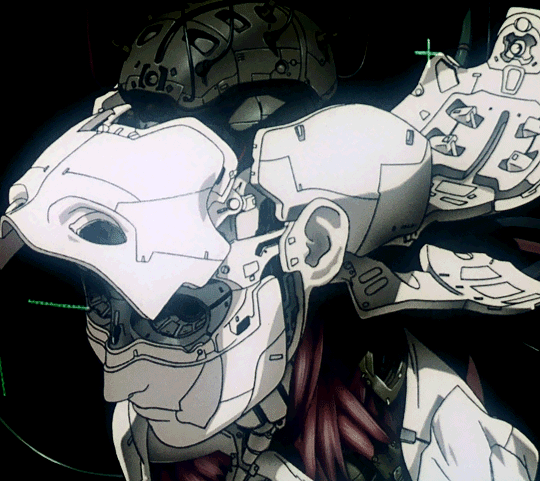
(Originally this was just going to be an excuse to talk about Ghost in the Shell... but I gotta be thorough.)
This was all brought on from this picture from a 1989 fanart magazine...
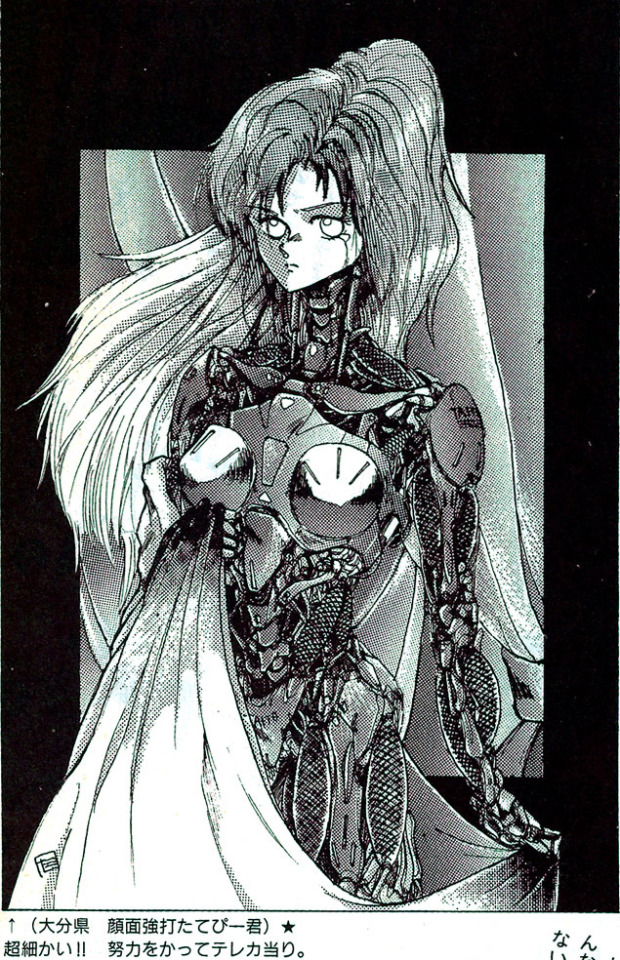
by an artist going by ‘Facepunch Tatebi-kun’ (顔面強打たてびー君, Ganmenkyouda Tatebii-kun). I remarked that it was interesting to see these kinds of ‘robot muscles’ in a picture from 1989, since I thought that kind of design became popular in the 2000s.
On some reflection, I think I gotta revise that opinion! I think ‘robot muscles’ became a thing around the mid 90s in anime; in the West I think it took a bit longer. But you can also see precursors already before that.
So. One thing artists are super into is biomimetic robots. That is, robots whose form (and perhaps function) is similar to animals, especially humans. The word ‘android’ referring to a human-like automaton dates all the way back to the late 19th century, but the modern ‘android, robot, cyborg’ taxonomy apparently became established around the 40s.
There’s two types of humanoid robot that get a lot of play, especially in anime. One is the convincingly humanlike cyborg, which is the same size and shape as a normal human; the other is a what we call in English a ‘mech’, i.e. a big robot you can sit inside.
Of course, if your androids just act like humans all the time, then there’s not much point having them be robots. To really create the frisson of contrast between human and mechanical forms you have to show the mechanism somehow. This could be because the machine isn’t perfectly human-like, and has visibly mechanical joints - take a look at the works of @sukabu89 for very inventive depiction of this theme - or, the android could be damaged or undergo maintenance.
When you attempt to translate biological forms into a more mechanical design language, the traditional way has been to use hard, rigid shapes, since these make the contrast especially clear. In more recent designs, particularly as we started to see real robots with ‘artificial muscles’ such as the ones created by Boston Dynamics, we get another sort of design language to express ‘mechanical parts’, and robots start having more biological forms with exposed plasticy muscles.
So let’s tell the story. We begin at the end of the 70s.
the dawn of mechaguro
For an early example of ‘mechaguro’ (a term I’m applying very anachronistically!), when a robot gets smashed up, we have Alien (1979). This film did a ridiculous amount to define sci-fi design language, and of course the alien itself blends mechanical and biological forms, with its glossy black surface allowing it to seem to melt into the exposed pipes of the spaceship. But let’s focus on the character Ash, a secret android who is broken apart in the second half of the film.
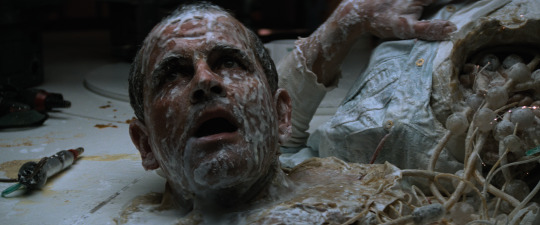
When Ash is torn apart by the alien, his insides consist of weird white plastic beads and a milky fluid that seems analogous to blood. It’s not clear what the function of any of this tech is - it’s intended to be vague and mysterious. The outside is biomimetic but the inside is anything but. He has a kind of artificial skin which resembles a latex mask.
The Terminator films are another major touchpoint for 80s science fiction. Late in the film, Arnie starts taking damage which reveals the Terminator skeleton underneath his fake skin.
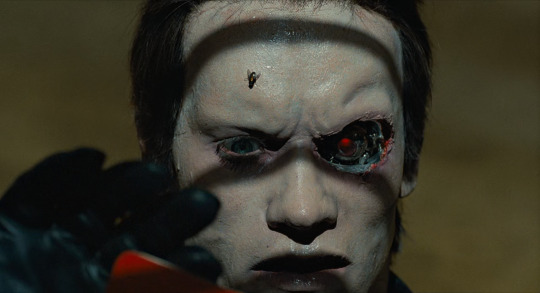
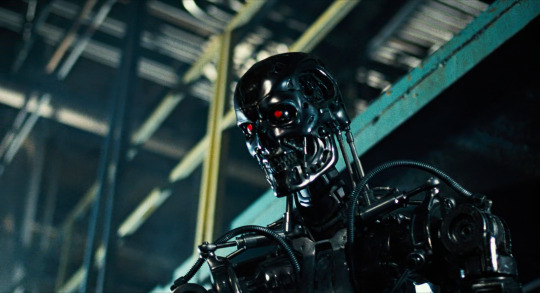
The stop-motion Terminator model is basically designed according to the principle of ‘replace human bones and muscles with hard metal bits’. So you have a metal skull, metal clavicles (which are pistons for some reason), metal shoulder blades, hydraulic pistons generally in the places where muscles are. e.g. in the above picture you can see pistons that stand in place of the sternocleidomastoid muscle, and in this picture...
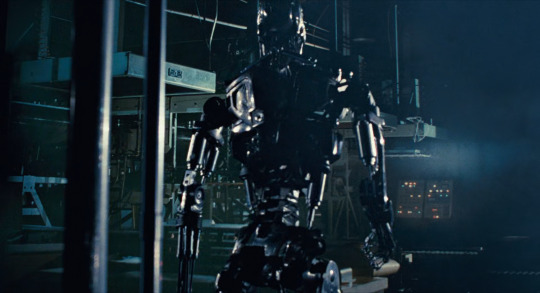
...you can see metal scapulae and piston biceps and triceps and a piston. The shoulder joint by contrast built in a very non-human-like way. Also there’s random tubes everywhere lol.
That’s generally how androids are portrayed in the 80s. The ‘droids’ in Star Wars are similar; C-3PO is an arrangement of metal plates with gaps suggestive of underlying mechanical details and rudimentary joints and pistons.
In Blade Runner, we have the Replicants, humanoid robots - but by the premise of the film, they are essentially indistinguishable from humans. So when the Replicants die, we never really get to see their robo-innards.
and now, anime
OK, that’s the big four Western 80s sci-fi movie series; what of anime? Of course, androids in anime go all the way back to Astro Boy. But most of these early designs don’t really focus on mechanical details all that much. Super robot designs are more like tokusatsu suits than anything. There were certainly instances of impressive mechanical animation in the 70s, with early experts including Kazuhide Tomonaga on Space Battleship Yamato. Then there’s Hayao Miyazaki’s episodes of Lupin III Part 2 which featured proto-Nausicaa flying a prototype of the robots from Castle in the Sky. It would be some years before anyone could come close to matching these!
The original Gundam in ‘79 famously started the ‘real robot’ movement [Animation Night, so let’s take a brief look at how a Gundam fits together.
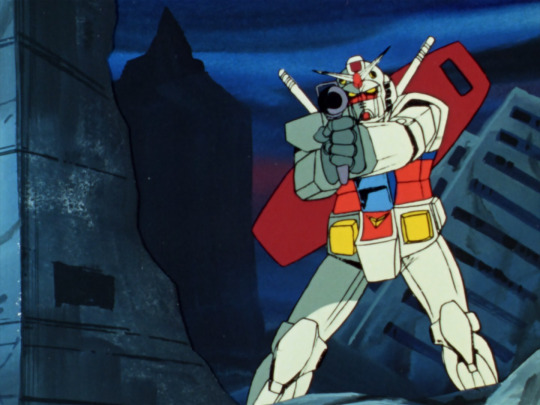
Generally speaking, the way Gundams are drawn in Gundam ‘79 is kind of rough. The methods to animate these rigid mechanical systems in super accurate perspective were just not yet established at the end of the 70s, certainly not on a TV budget. The actual joints on the Gundam are left very vague, but it broadly speaking seems to move like a human in armour.
But the OVA boom was about to begin, and while it would be a while before we saw the heights of Headgear/Production I.G./Gainax, things were going to change a lot. Mechanical design and animation was about to get much more sophisticated very very quickly.
In 1982, we have Super Dimension Fortress Macross, with robots that transformed into fighter jets. Its robots are designed by Kazutaka Miyatake, who cut his teeth doing mechanical design for Space Battleship Yamato and Daicon. The Macross TV series introduced the world to the animation of Ichirō ‘Missile Circus’ Itano. [AN64] A plane with legs... honestly looks kind of goofy, but Itano’s ambition to have a highly mobile 3D camera that could move in ways that would simply be impossible in live action marked a huge step up in how robots are animated. And this would get refined even further in the film Do You Remember Love.
In terms of design, we’re really moving our inspiration from ‘tokusatsu suit’ to ‘military hardware’ here. A Macross suit has to look like something that could transform into a plane, so its silly little arms and legs have to look kind of plane-like. In any case, we are definitely still in a world of hard and rigid robotics.
Dallos (1983-4) dir. Mamoru Oshii is known as the first OVA, if not the first successful OVA [AN115]. It features a variety of mining robots on the surface of the Moon, which are generally less humanoid, taking their design cues from JCBs...

...as well as humanoid robots with fairly clear joint patterns...

...and more humanoid robots too.
The eponymous Dallos, however, is a huge humanoid robot that looks like this...
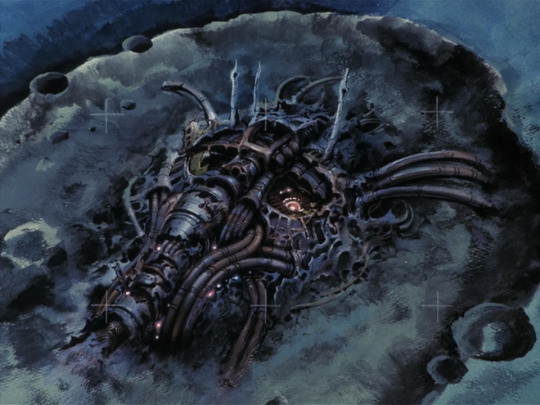
Here we have a pile of mechanical shapes that vaguely calls to mind a human face. It’s suggestive of motifs we’d see later in works like Akira.
A year later in 1985, Megazone 23 really kicks off the OVA boom in earnest [AN 103]. It also has a robot, in the form of a transforming bike that can become a humanoid piloted mech...
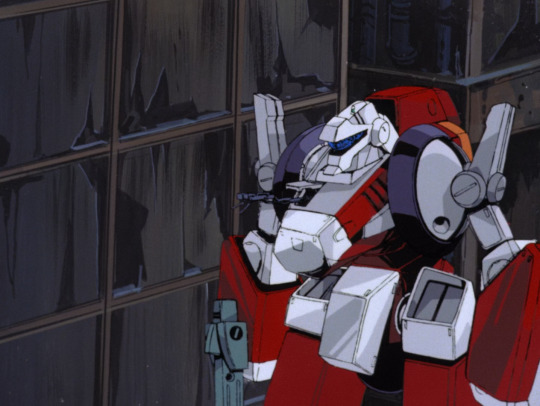
You can see mechanical designs and shading have become considerably more detailed; its motion is a lot more complex as well with a ton of indulgent background animation shots. The actual details of the bike -> robot transformation are rather brushed over. But to sort of sum up the design language: we have organic but hard-edged shapes contrasted by inorganic but round shapes. (These terms ‘organic’ and ‘inorganic’ refer mostly to symmetry and a sense of ‘flow’ in the shape.) There are few right angles as such, but a lot of broadly boxy topology. The shapes are broken up by elaborate specular highlights in complex shapes, a motif of the later Kanada school.
OK, but that’s all variants on ‘rigid robot’ so far - what about the androids? What about the more directly biological designs?
Following the enormous success of Megazone 23 Part I, Toshiki Hirano got the chance to adapt his favourite lesbian cosmic horror hentai manga Fight! Iczer One into a rather more tame OVA which released from 1985-87. In terms of mechanical design, this starts to do some interesting moves towards blending biological and mechanical forms...
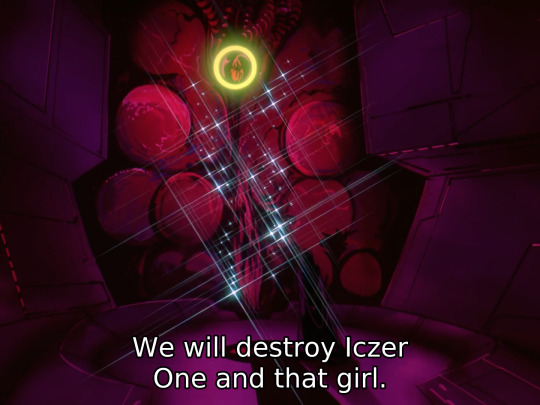
Of course it has a robot in addition to the requisite bishōjo and lightsabers. In contrast to the boxy shapes we’ve seen so far, the robots in Iczer-One have a much more curvy organic sort of design language. Still, there is not a lot of emphasis on the precise details of mechanical articulation outside of select shots. (It is however notable for the first ever Obari punch!)
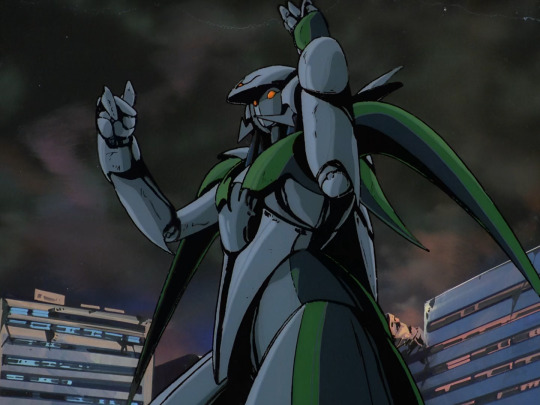
Despite the change in shape language, these are still very clearly animated as metal plates and not yet muscles.
In 1984 we have a very important film (for this narrative, and in general), Nausicaa of the Valley of the Wind, the film that created Studio Ghibli. Here we have the ‘God Warriors’, giant humanoid weapons with the ability to shoot a massive laser out of their mouth. Rather than robots, these are very much biological in nature, having to be grown in a kind of cocoon. In the film version of Nausicaa, an incomplete God Warrior is released, leading to an iconic scene animated by Hideaki Anno in which the God Warrior attempts to blow up the oncoming wave of Ohmu.

The God Warrior’s melting flesh is gorgeously animated, bubbling and sloughing off in great big lumps as the skeleton pokes out from underneath. Throughout, Nausicaa is full of beautiful and impressive animation of both machines (mainly planes) and biological (the giant insects), but the God Warriors, as human-made lifeforms, bring the two together. However, this strand wouldn’t be especially followed up on for a long long time.
Right, but what about Bubblebum Crisis (1987-91)? That is, after all, the iconic 80s robot girl OVA. It’s inspired heavily by Western robot-related films like Terminator and Blade Runner; here we have ‘Boomers’ (never stops being funny) as androids that can appear convincingly human. Like the Terminator, the underlying metal parts can burst out. Here we have a metal frame designed to resemble muscles, and also metal tentacles.
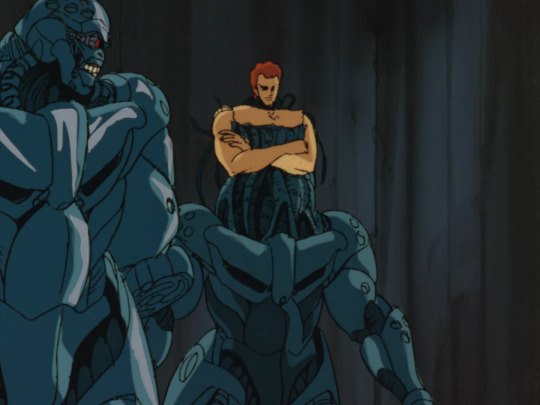
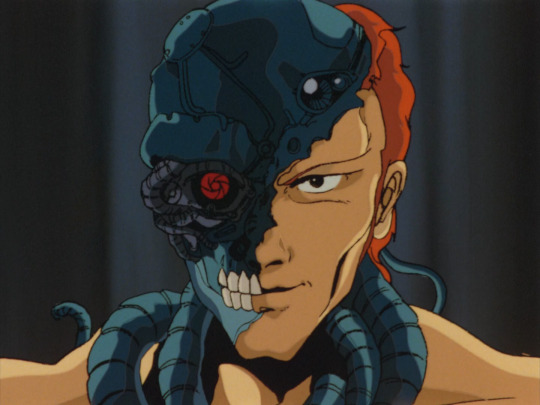
The shapes of these robots are a lot more organic. The robot neck has tubes that sort of resemble the neck muscles, metal plates that resemble pectorals and abs and deltoids and biceps and so on. You’ve even got a direct riff on the Terminator ‘fleshy face falling away to reveal metal skull with glowing red eye’! Under the plates there are clusters of tubes which also heavily resemble muscles. Also you’ve got the classic ‘three small circles’ motif there.
Contrasted against them are the Knight Sabers, who aren’t cyborgs as such but fight in powered exoskeletons which fit the design motifs of robot girls.
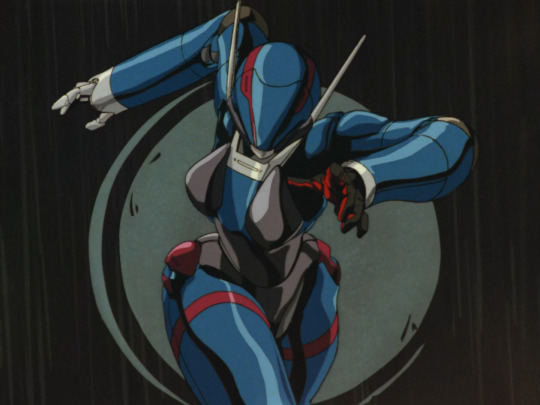
These suits are quite form-fitting, with a rubber under-layer and metal shells on top. There is definitely some attention paid to how they’ll articulate around the joints. One very recognisable 80s motif is the sort of extending spike thingies you can see on her hat there; there’s also the jets that extend out behind the suit. And, you have that multi-layer shiny highlighting of course!
Still, the way the characters move in Bubblegum Crisis is still very squarely Kanada School poses; big movements, lots of held poses accentuated by flashing and line boil, not a lot of concern for conservation of momentum or anything like that.
For a contrasting strand we can look at the rise of the ‘Otomo school’ (if you will) of realism. Around the end of the 80s, a pool of talented animators were gathering around Katsuhiro Otomo. Their most famous work is Akira, but I’m actually going to begin with Robot Carnival (1987), a wonderful anthology of short films from 1987. This features a huge variety of interpretations of the concept of robots.
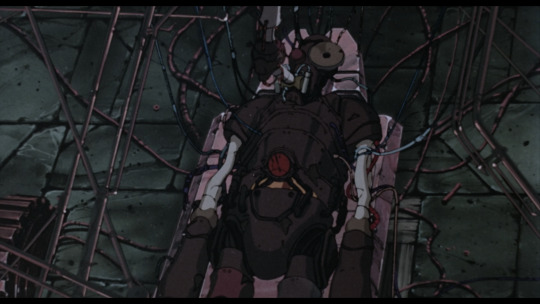
For example, for Kōji Morimoto, later co-founder of Studio 4°C, the robot is a kind of cobbled-together steampunk Frankenstein’s monster. It’s a very cool design with all sorts of asymmetries and exposed parts suggesting its cobbled-together nature. And although all the robot does in this short is stand up and then fall over, a great deal of attention is paid to the little details of its articulation and its movement through space.
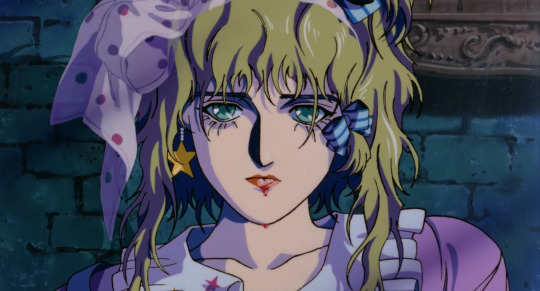
Presence, directed by Yasuomi Umetsu, is notable for its steps in the direction of realism - Umetsu’s characters are hyperdetailed and in some ways over-drawn. The opening shots establish this is a world where lifelike androids are common, when an android gets his head kicked off and stolen by children. Here the robot-as-doll metaphor comes in, something that will be increasingly central in the next decade. The robot girl is essentially a human-sized doll in a room full of other toys. Her creator smashes her to pieces with a wrench; later her ghost visits him as an old man. We see the girl attached to a bunch of wires, but she bleeds like a human.

Cloud by Manabu Ōhashi features another humanoid robot, an Astro Boy-like child recognisable as a robot based on his segmented torso and legs and robotic ear... cones. Here the robot is a standin for human emotions, the boy’s struggles projected onto the constantly changing sky as he walks against the wind.
Strange Tales of Meiji Machine Culture: Westerner’s Invasion by Hiroyuki Kitakubo (later to direct Golden Boy, Roujin Z and Blood: The Last Vampire) is a sendup of mecha shows in which two very goofy looking steampunk robots operated respectively by Japanese and Western crews duke it out, laying waste to the city around them. The Japanese robot is basically a big wooden samurai...
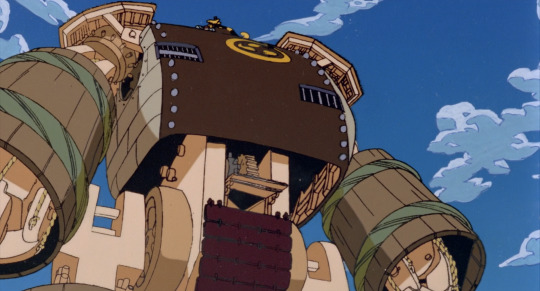
and the Western (more specifically American) robot is, uh
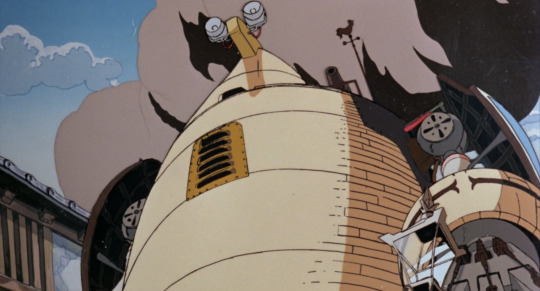
sorta big barrel with little eyes on top? I’m not entirely sure what the deal is with this design!
That’s really not relevant to our story tbh I just think it’s a neat short.
Chicken Man and Red Neck, by Takashi Nakamura, features especially distinctive robot designs. The film is kind of a dream sequence in which a terrified drunk man witnesses the revels of the machines of Tokyo, transformed into robots; the robots are extremely shaped, moving through a world that is pretty much just pistons...
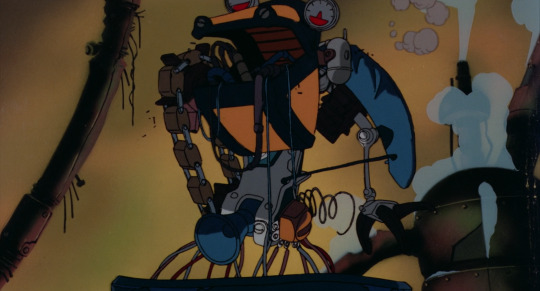
These robots call to mind the dancing demons in Fantasia’s Night On Bald Mountain sequence, or even Bosch.
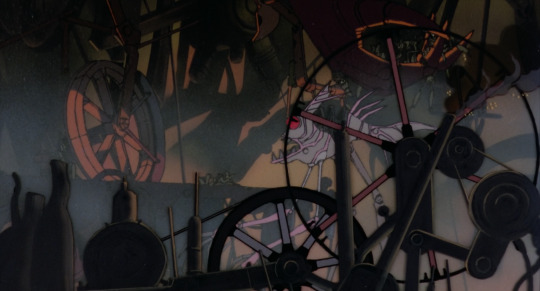
Otomo’s own segments feature the Robot Carnival itself, a vast mechanical structure built as... well some kind of entertaining spectacle, but which now drives around the post-apocalyptic wasteland dropping robots which explode as bombs. It’s cute.
OK, to wrap up the 80s, we gotta cover Akira (1988) [AN34]! Akira has plenty of impressive mechanical animation of helicopters, hovercraft thingies, satellite lasers and of course the famous bike, but it doesn’t really feature robots as such - but what it does have is a blending of mechanical and biological forms in its climactic sequence where Tetsuo’s psychic powers go out of control. First, wires start to spread like the roots of a plant from his robot arm - less an actual machine and more something he assembled with his psychic powers...
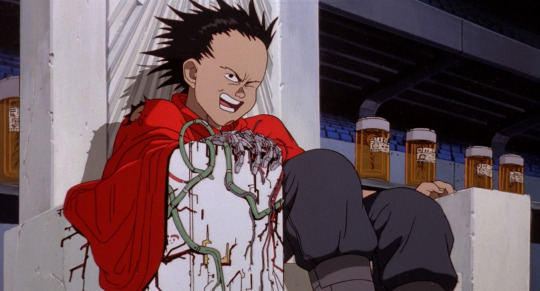
He takes a bullet, and the mechanical wires and muscles start to blend together and spread out like a slime mold...
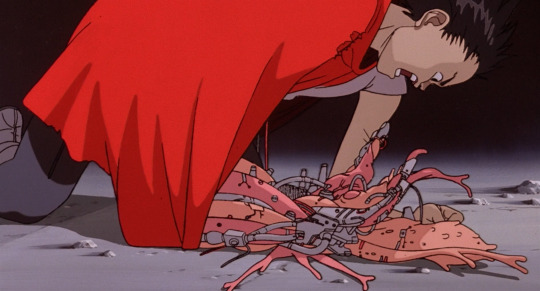
...which he can extend as essentially a giant tentacle.
When his powers fully go off the rails, he bulges out into big blobs of flesh which have both veins and wires running over them. These burst out of the metallic parts as well.
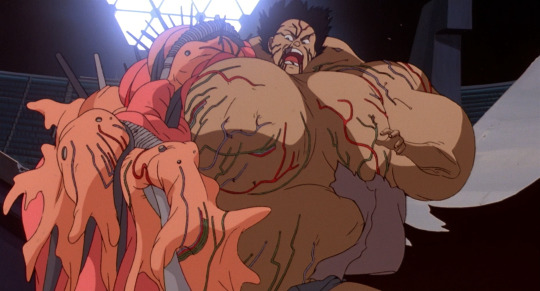
He turns into essentially a giant biomechanical baby.
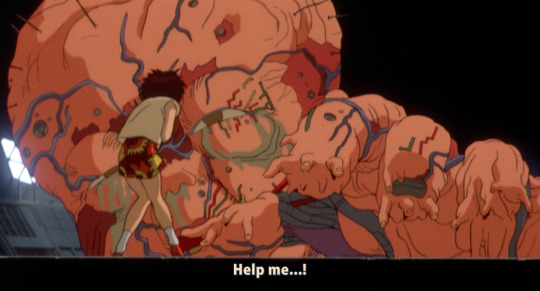
Did Akira invent these images of blending biology and machinery? Probably not, but I’m not really familiar enough with manga of the time to say. What can at least be said is that Otomo’s absurdly meticulous style could really sell it. Otomo was truly a god of perspective and detail; Akira the film was an enormous, prestigious production that threw ludicrous effort and resources towards realising his vision (which doesn’t mean it paid its inbetweeners much more...). A lot of the animators who worked on Akira would go on to be prominent in...
the 1990s
So, the 1990s. If the 80s was dominated by the later Kanada School, the new movement of the 90s, at least as far as film animation goes, was ‘realism’.
But before we get onto that, let’s take a brief look at Gunnm (1990). Known as Battle Angel Alita in the West, this manga by Yukito Kishiro depicts a world in which most people are cyborgs; it was adapted to an OVA by Madhouse in 1993 and became wildly popular overseas. Its protagonist Gally, aka Alita, starts out the story as a wrecked cyborg body like this...
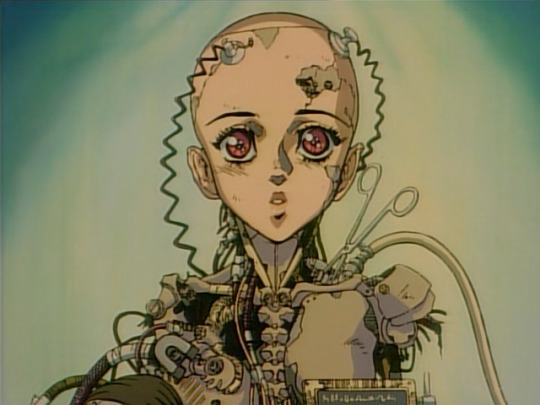
Looking at this design, you can see similar patterns as we have so far. We have metal clavicles, metal sternocleidomastoid muscle, metal pectorals, metal spine. There aren’t robot muscles, per se, but there’s a lot of attention to detail on mimicking biological shapes.
Before long she is rebuilt (twice in the manga, once in the anime). Her new body is like this...

...which is to say a skintight bodysuit in the middle, and metal arms. These arms, although designed in a way that indicates hard surface and with a hinge joint at the elbow, are designed in a way that mimics the flow of muscles in a human arm. By contrast, her sorta-love interest Yugo has a body like this:
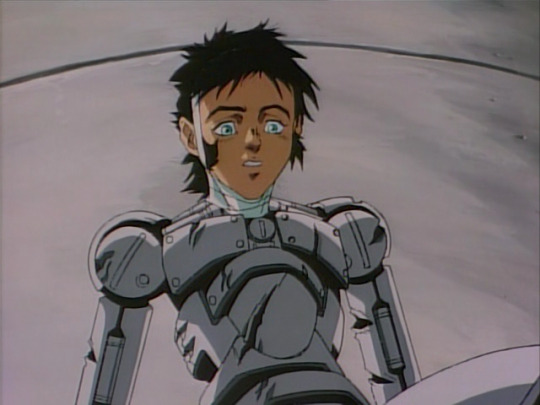
which gets mashed to pieces in the finale of the OVA. There’s a striking mechaguro scene in which Gally catches Yugo, but leaves him hanging by a fraying arm, which snaps, leaving him to fall to his death. Compared to later iterations of the ‘robot arm torn apart’ device, this one’s relatively light on detail...
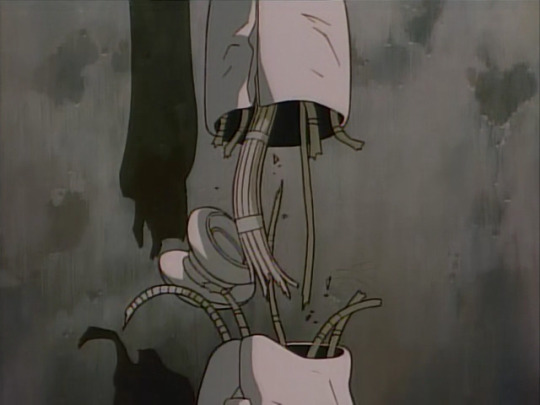
Cyborg bodies in Gunnm are used as a visual indication of character type. Gally has curves but also sleek robo muscles: she’s a Beautiful Fighting Girl, sweet but also extremely powerful. A huge ‘muscular’ cyborg with wide shoulders is likely to be a brute. Yugo here has much more plain, simple shapes with visible bolts, not precision pieces like Gally.
I don’t know how much of this originates with Gunnm. I’m sure the idea of cyborg girls was in the air long before, but this became an influential example on the tail end of the time of the 80s bishōjo. One device that is notable here is the idea of a ‘full body cyborg’, which is only human down to the brain (or perhaps not even that). Body swapping is a major theme in Gunnm, something that would be expanded on before long...
And if that was going out, what was coming in? Let’s look at Patlabor, which traces the evolution of the Headgear artistic collective and IG Tatsunoko into Production I.G.. This is about as down to earth as giant robot stories can get, with robots as just everyday machines used for work and by the cops. But where things really go nuts in animation terms is the opening to Patlabor 2 (1993).
youtube
Here you can see some of the most impressive sequences of mechanical animation ever drawn. We see pilot Noa testing out the robot, and especially notable are the scenes of the hand flexing and of walking. Enormous attention is paid to the articulation of joints. The robot’s hand can swivel 360 degrees, unlike a human; however, like a human, the articulation of the fingers seems to be controlled by hydraulics in the forearm (whereas in humans, the muscles and tendons in the forearm control our fingers). When the robot’s foot steps, it flexes like a real human foot, with believable joints, and a sensible arrangement of pistons to absorb force.
It’s not imitating a human’s muscles, but the attention to the details of the robot’s mechanical design serves precisely to draw our attention to the ways it’s like/unlike a human - the robot’s hand impossible motion immediately contrasted with its pilot shot from the same angle. And the perspective drawing is absolutely impeccable. The robot is made of purely rigid structures, and the way rigid structures articulate is not at all how a human’s joints articulate.
The sequence above was animated by Atsushi Takeuchi. But across the board, the bar was getting pushed for mechanical animation. For example, observe this cut from Mobile Suit Gundam: The 08th MS Team (1996-1999), in which the robot tears off its own arm and beats up another robot. The precision of the way the joints are animated and the way the robots move in space is just completely on another level compared to what Gundam had been doing a couple of decades prior.
Anyway, we’re here to talk about robot muscles, and we’re just a few years out from that now!
The year that robots got muscles, at least as far as anime is concerned, is 1995.
You can probably guess the next part. In 1995, we get Eva and GitS. Let’s start with GitS, to continue the Production I.G./Mamoru Oshii thread. The opening sequence of GitS, animated by - who else could it be? - Hiroyuki Okiura - has to be one of the most iconic segments of video ever drawn. Here’s a merely 720p youtube upload but go and find the place you have GitS stored on your hard drive and watch it in proper quality eh.
youtube
OK, yes, a lot of it is a naked lady floating around, sue me or whatever. But the sense of form. We see early on an appearance of ‘robot muscles’, here closely resembling real muscles...
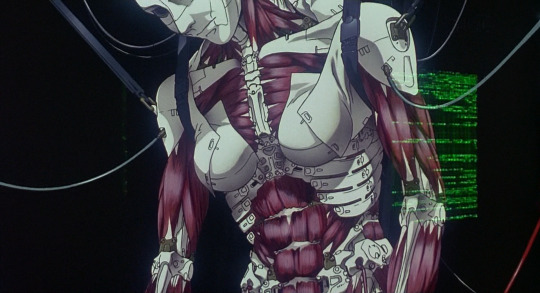
We can see from the way this is drawn that it’s made of a combination of artificial muscles, solid segments, and flexible, fabric-like panels. One of my favourite shots at the beginning shows the solid segments of the skull clicking into place. Here we have a very clear contrast between the angular, hard edges of the mechanical pieces against the organic forms of a human body.
Elsewhere in the film, we see various incredibly cool bits of ‘wouldn’t be fucked up if a body did this‘, like the fingers...
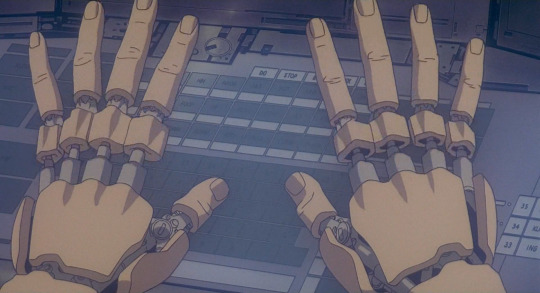
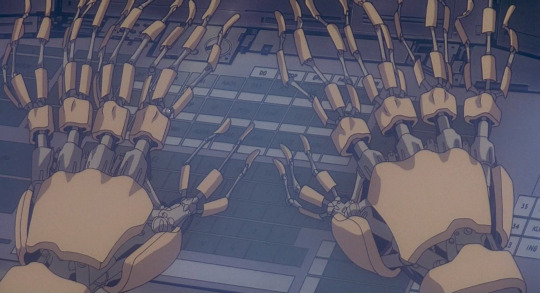
Here, what we expect to be soft biological fingers is contrasted with unexpected rigidity, mechanical joints under a shell.
Also in this scene we encounter a robot body that has been stripped of her arms, legs and hips but is nevertheless still alive...
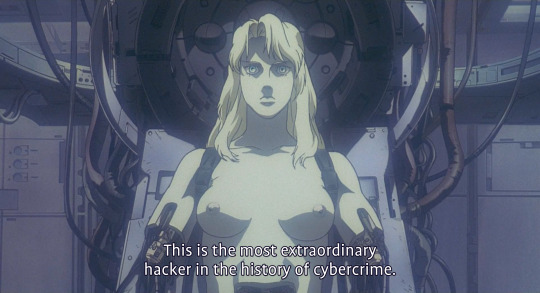

most extraordinary hacker in the history of cybercrime and you have your titties out and yet you still can’t get them to stop misgendering you, smh
For the Terminator, having its body smashed up and continuing to walk was a demonstration of its strength. Here, as would become perhaps an increasing motif, having a robot body is a source of vulnerability: people can do things to you that would kill an ordinary human but you keep going through it. Not surprisingly, ‘robot body maintenance’ is a recurring porn device. (One that GitS deploys in SAC s2).
But of course this all builds up to the all time classics of mechaguro scene at the ending where the Major attempts to tear off the hatch of a spider tank. Muscles ripple individually under the surface of her skin, her arms bulge in exaggerated contraction, and then her arms fully tear apart under the force.
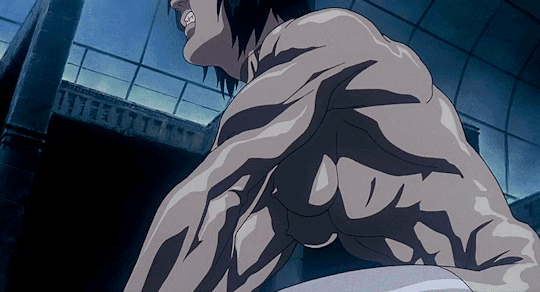
Here, we’re showing her as mechanical not by contrasting rigid forms with biological ones, but by exaggerating the biological ones to the point of doing something extremely unnatural. Human muscles do not generally flex in such an individual way, nor are they strong enough to tear the arm apart, but robot muscles? Yeah, they could do that. This sets up the next scene where the Major lies unnaturally still, but can still exert control through hacking through her union with the Puppet Master.
Robots holding onto something so hard their arms explode has become... if not a recurring image, then at least one that was called back decades later in Violet Evergarden.
The final scene of GitS brings back the image of robot-as-doll, with the Major’s consciousness now uploaded into a black-market robot body that resembles a child in a dress.
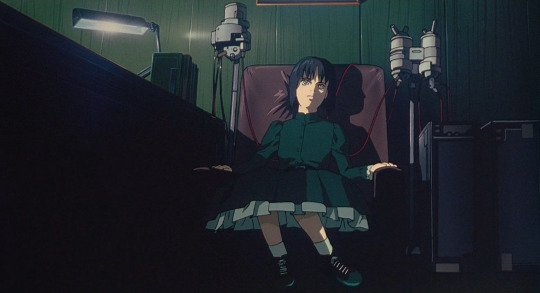
This is further expounded on in Oshii’s second GitS movie Innocence (2004), with its Ballade of the Puppets in the soundtrack as Batou and Togusa (and eventually, the Major) are attacked by essentially an army of ball-jointed doll gynoids. The puppets’ movements are extremely unnatural and erratic acrobatics, constantly flipping all over the place; when hit by bullets, panels pop open to reveal the underlying brass skeleton. It’s a very cool image. (The thing that lets the sequence down is the extremely dated CGI and aggressive digital compositing.)
It also has Donna Harraway as a literal cyborg!
Now, the GitS movies didn’t drop fully formed out of nowhere, but draw on the work of Masamune Shirow. The manga has a somewhat different design sensibility than the movie, distinctive and shiny as all Shirow’s art. It is more rounded and organic, less cold.
So, the basic design of a cyberbody originates with Shirow. You can see it on this page (unfortunately from a flipped version, translation Dark Horse):

You might be able to determine from how the nurses are dressed that, yeah, the GitS manga is in significant part fetish porn. But really nerdy fetish porn, which is the best kind. This chapter is almost entirely dedicated to explaining how cyborg bodies are constructed in great detail, from the ‘sensory film’ (that’s what’s being applied in the opening to the 1995 film) to the hair implantation.
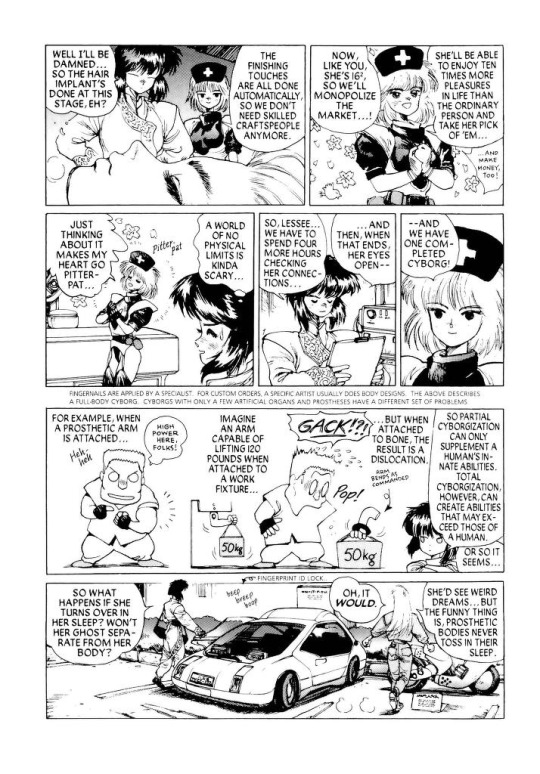
It’s interesting seeing how some of the more out-there designs of the manga, like Chief Aramaki, are transformed into the realist style of Hiroyuki Okiura. It’s Okiura, so it works great of course.
I don’t know if there are manga examples of such detail about cyborg bodies that predate Shirow.
Anyway, that’s just one of the two punches dropped in 1995. The other is Neon Genesis Evangelion. To the pedants: sure, the Evas are not actually robots, but they’re giant cyborgs that play the role of ‘robot’ in the story and they look like robots so I’m counting them.
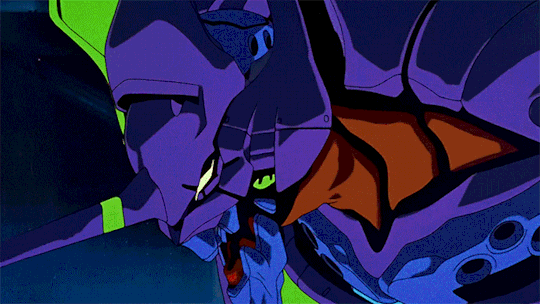
Anyway, the thing about the Evas is they are incredibly lithe. They run, rip and tear and swing heavy objects around in a way that’s both weighty and distinctly biological. Their bodies are extremely flexible compared to prior mechs (look at how much the spines bend in that Iso cut from EoE!), but not without hard, rigid components such as the shoulder towers. Their jaws are bestial but feature mechanical-like components like interlocking hexagonal teeth and jet-like vents. They are in short a fantastic design that blends biological and mechanical features.
The impact of Eva on just about everything can’t be overstated, but as far as robot design, well. There certainly were works that leaned on the precedent set by Eva, as for example RahXephon, which also treats robots as something spiritual, prone to popping into a blob of weird little bubbles just like in Eva.
There’s a great deal missing from this account. I am very focused on anime because I’ve watched a lot more anime than I’ve read manga or played games from this period. So I’m sure there’s major foundational works I’m missing here!
the 2000s
When did the West start to catch up? eh that’s subjective - David Cronenberg was way ahead of the game! - but specifically in the sense of robots with mechanical muscles, I think the major points in the timeline go a bit like this.
In 1999, there’s the Matrix, which leans heavily on anime. This features a similar ‘robot takeover’ premise to Terminator, but here it’s biomimetic robots modelled after squids, with clouds of constantly moving tentacles that sweep behind them. After making a cool half a billion dollars, the Wachowskis decided to pay all their favourite anime directors to make short films. I’m not going to comment on every part of the Animatrix, since most of it isn’t really relevant, but I will point to this horrifying cut by Takeshi Honda in The Second Renaissance in which a robot woman has her clothes torn and then skin bashed off by a mob. The framing, motion, her expression of abject terror, and the ‘reveal’ of her ‘true’ nature, all viscerally call to mind a trans bashing.
On the manga side, a big one to mention is Gantz, a gory nihilistic seinen manga which ran from 2000-2013. The characters in Gantz fight in special latex-like suits which take on the appearance of muscles while engaging superstrength, but can also sustain damage that causes them to drip fluids from ports located at the neck and become fatal to their wearer. Gantz was adapted to anime by Ichirō Itano in 2004, but I haven’t seen it so I can’t comment on any notable animation.
Cyborgs are a favourite subject of games, but in the 2000s, games are really pushing art direction and biopunk stuff is in. Half Life 2 (2004) has its spider-crab like Striders and dropships and so on. Oddworld: Abe’s Oddysee (1997) bases its whole concept around the sheer variety of weird creatures that would inhabit its dystopian factory. And I gotta give a shoutout to Septerra Core (1999) - in case one other person has played that lmao
At some point after 2005, Boston Dynamics became a viral sensation thanks to their robot BigDog. BigDog is just welded steel and hydraulics, but its lifelike hopping movement style definitely brought to mind the idea that the future of robots is going to be in biomimesis.
So, 2007, here comes Crysis to melt your PC! This is an FPS with the not-uncommon premise of being a supersoldier fighting (country America hates) and also aliens, but its gimmick was that you have a special exosuit that wraps around your body with artificial muscles, making you much stronger and manlier or whatever.
youtube
This is indicated by a visualisation that could be right out of a toothpaste ad, where tiny little balls drop into the character’s pores and somehow go straight into the bloodstream which is of course a void full of flying red blood cells. And so on. It sold the game, though! The ad there focuses almost entirely on the suit and not the character wearing it, who is basically an irrelevant soldier man. What it entailed in gameplay terms is that you have a mode switcher so you can have strength or armour or invisibility or whatever. But it’s cool military superscience, you see!
Anyway. Not like my preferred flavour of cyborg is any less stupid I guess x3
In the same year, Bayformers started. These films’ robots are honestly just visual noise, there’s so many moving metal shards going every which way that it’s next to impossible to discern any sort of underlying mechanical principle. A similar ‘overwhelming business’ visual effect would be applied the next year in Iron Man, kicking off the MCU. So mechanical muscles definitely weren’t the only expression of ‘hyper-advanced robot’ in Western visual media in the late 2000s.
I’m going to end my story with two more games: Horizon Zero Dawn and NieR Automata.
Horizon features a world inhabited by a large variety of robot animals, using the peak of AAA rendering techniques. The robots are designed to be biomimetic after both modern animals and prehistoric ones, and feature a combination of hard surfaces and softer biological muscles. For example, a robot horse:
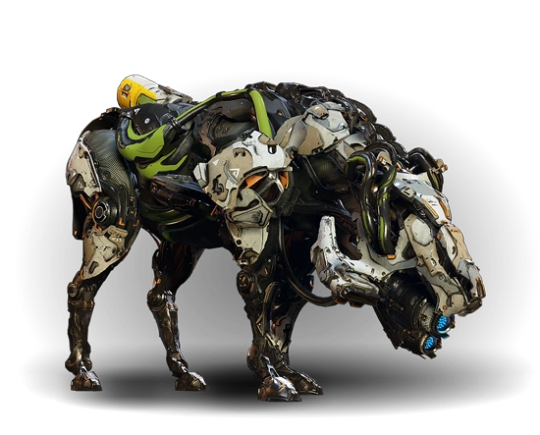
The discipline of making designs like these now has a name: it’s called ‘hard surface modelling’ and it involves boolean operations and bevels and other techniques designed to create a balance of hard edges on a surface against the smoother parts. The design language of Horizon says that the hard plates are white, the soft parts are very dark and may be patterned like a cloth texture, and there can be small colour accents here and there.
I think you can definitely see the influence of Boston Dynamics’s robots (and recent military tech in general) in these designs, iterated on through a decade and a half of increasingly intra-referential concept art. They are visually very busy designs, but there are a couple of recognisable features that draw attention by being inorganic, such as the cylindrical fuel tank at the back. Vitally, the silhouette is very readable.
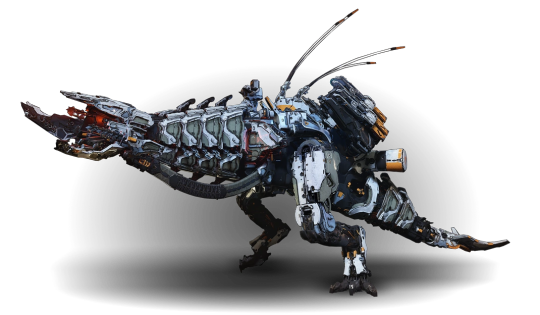
This robot T. rex for comparison serves as a world boss monster, and you can see it’s got a bunch of military looking attachments that look like radars and missile launchers and so on. As real tech evolved, so too did our idea of what a scary robot ought to look like.
So, that’s where this kind of design pattern has gone in mainstream games.
Now to finish, a brief comment on NieR Automata. Its designs draw hard on those of Ghost in the Shell. Visually it draws a strong contrast between the Machine Lifeforms, who have inorganic shapes (spheres and cylinders) and very visible and plausible mechanical joints, and the doll-like androids, who might as well be human (although A2 provides some contrast in an android who is damaged enough for the underlying materials to show through). The mechanical nature of the androids is communicated by the acrobatic way they move and the interface elements, and dead androids you find in the field - and later when they start losing arms and stuff, it’s a whole thing. But just like humans in Yoko Taro Games, they’re capable of dying in a puddle of blood.
(I guess if you take one thing from this post it’s that if you’re a robot, don’t expect to keep your arms.)
Robot muscles gives you a chance to give both the ‘anatomy porn’ of drawing something very precisely right, with the added bonus of giving you a reason to draw the muscles écorché, and the chance to make it weird and defamiliarised by splitting it with mechanical elements. In short... they look cool!
In this whole post I’ve basically not touched at all on illustration. I can point to a variety of illustrations of robot girls, but in terms of periodising them, I just don’t think I know enough. Though it’s safe to say that cyborg bodies in various states of construction or disrepair are now a mainstream of concept art - and that Ghost in the Shell is usually cited as an influence. I don’t know if robot muscles ever truly became the mainstream way to depict a robot, but it does feel like they’re increasingly common.
One artist I will briefly mention (besides sukabu), mostly bc I think they’re neat, is Haruyo Megurimu, who draws these very intricate designs of ‘necrotech’ which is sort of very biological robots extending out of human bodies - limbs extended on long spindly insectoid strands, jaws splitting open, that kinda thing. Can’t say who influenced them or anything but it’s a compelling extension of the idea into a particular corner of aesthetic space.
And that’s all I’ve got I think. There’s definitely big gaps like. More recent sci-movies. Western comics. Nevertheless, that’s an arc.
If you’ve read this far: thank you for indulging my autism.
807 notes
·
View notes
Text
robot girl except she doesn’t have a humanoid body or a grasp on human language or even a vaguely human size and she’s actually just my personal TI84 handheld calculator with a pretty bow
157 notes
·
View notes